Home » Posts tagged 'google voice' (Page 16)
Tag Archives: google voice
Here We Go Again: Getting Ready for the Next Google Voice Train Wreck
Self-inflicted wounds are nothing new in the technology business, but Google spent much of last week working hard to take top honors for what is clearly one of the most selfish and short-sighted moves ever in the telecommunications marketplace. Less than a week after extolling the values of open source technology during Google I/O 20131, Google wasted little time performing a complete 180 by deep sixing further support of the open source XMPP protocol for messaging and VoIP communications. With one brief announcement, Google basically killed off years of Google Voice development and announced the upcoming demise of Google Voice, XMPP, and Jabber messaging as we know it. Never mind that literally millions of users have come to rely upon Google Voice and XMPP messaging as their primary sources of communications. Google now has declared XMPP too confining for their view of what the telecommunications world really needs. Instead, we get yet another proprietary communications protocol. So much for the Do No Evil ethos. With classic pot calling the kettle black ire, one of Microsoft’s leading cheerleaders wasted little time condemning the move.
So why the sudden change of heart at Google? Well, it had nothing to do with the needs of Google customers obviously. In the old days, Google at least labeled projects as beta (for years) to warn you that something might happen down the road, good or bad. That era is over. Now the carnage happens almost randomly. Remember Google knols? It was perhaps the greatest collection of medical and technical literature of all time. Poof! All gone. We won’t go through the entire litany. Suffice it to say, this is nothing new for Google. Every company is entitled to its New Coke moment. Google has had more than its fair share, and it should serve as a wakeup call to organizations and individuals that reliance upon Google infrastructure is a really bad idea.
The current train wreck turns out to be yet another turf war motivated by retribution against Microsoft’s recent decision to support XMPP in its Outlook.com unified messaging product, something most companies would have greeted with jubilation. Instead, Google is miffed that Microsoft was now supporting its messaging protocol while continuing to keep its own protocol proprietary. That meant Microsoft cellphones could chat with Android phones but not the other way around. The moral of the story for consumers is pretty simple. Don’t for a minute assume that any technology company has your best interests at heart. None of them do. It’s all about money and industry domination. Google viewed this as a brazen attempt by Microsoft to create a messaging platform that could speak Android while continuing to restrict access to the Microsoft messaging installed base. And Google chose to pick up its marbles and go home rather than hand Microsoft easy access to hundreds of millions of Android cellphone users. So we’re back to handing the Bell Sisters the unified messaging monopoly with SMS and MMS as the lowest common denominator. Welcome to Big Business!
What does all of this have to do with Google Voice? Well, it rides along on the same messaging platform as Google Talk, Microsoft Lync, and XMPP/Jabber-based solutions including Asterisk, FreeSwitch, Yate, Cisco Jabber, Openfire, and Avaya in addition to all of the Google Voice-compatible softphones and OBiHai devices. So expect a train wreck!
We’re all about VoIP communications so we’ll leave the cellphone messaging for others to sort out. The important question for those of us that depend upon Google Voice for VoIP communications is what can you do to insulate yourself from the upcoming disaster. You can bury your head in the sand and pretend this isn’t going to happen, and you’d be dead wrong for the reasons we’ve outlined above. And, remember, Google has served clear notice that XMPP is over as far as they are concerned unless Microsoft, Apple, and now Facebook blink. Of course, Google could always redeploy SIP for Google Voice calling. If you think any of that is likely to happen, you also might want to buy a lottery ticket which affords you about the same chance of seeing any of your dreams come true.
To keep things simple, let’s divide VoIP communications into four categories: inbound calling, outbound calling, messaging, and faxing. We’ll leave video for another day only because it remains a niche product. With the demise of Google Voice, we recommend not putting all of your eggs in one basket (again). Inbound calling is the most critical. That’s your phone number, and it’s how folks get in touch with you. If there are numbers (DIDs) that you don’t want to lose, now is the time to move them away from Google Voice before it’s too late. If Google elects to shut down Google Voice, your ability to port your numbers elsewhere is OVER! So don’t procrastinate on this one. Luckily, Vitelity (one of the primary supporters of Nerd Vittles and the PBX in a Flash projects) has provided an incredible deal to our fan club for many, many years. For $3.95 a month you get a DID with unlimited inbound calls. It’s not free, but it’s not expensive either. And the call quality and service reliability are as good or better than anyone else in the business. You can read all about the offer at the end of this article. Google charges $3 to port your number out of Google Voice to a new provider. The step-by-step tutorial is available in the PIAF Forum. Do it while you still can!
For outbound calling (terminations), the thought process is different. Unlike traditional analog telephony, there is no reason not to have multiple providers especially if you’re using Asterisk, PBX in a Flash, or Incredible PBX as your communications server. If one outbound path fails, your server can automatically send the calls out through another call path. So continue to cling to your Google Voice dream for outbound calling if you’re a Believer. But do a little advance planning while there’s no crisis. There are numerous termination providers and generally you get what you’re willing to pay for. If cheap is your primary objective and call quality is secondary, then Anveo Direct and VoIP.ms can’t be beat. Both allow you to spoof your CallerID to match a DID that you own so they work well with a service such as Vitelity that is being used to handle your inbound calls. We’ve written about both of them, and we use both of them with excellent results. There are many, many others. Visit the PIAF Forum for lots of additional recommendations.
SMS messaging is an evolving technology in the VoIP marketplace. Expect to see some terrific new services before the summer is over. If you’re in a hurry, the easiest current solution to implement is through Anveo Direct. Our recent article will walk you through the setup process to send and receive SMS messages with Asterisk.
Faxing remains a crap shoot using VoIP technology. If you want commercial quality, then choose one of Vitelity’s dedicated fax circuits. If you want analog faxing that usually works, then Anveo Direct and VoIP.ms are about as good as you can do. All versions of Incredible PBX for PBX in a Flash include a free faxing solution using the HylaFax/ AvantFax platform. A similar solution is provided on the Raspberry Pi platform. As we said, it’s not perfect but it usually works.
Continue reading Part II: Google Puts the Final Nail in the Google Voice Coffin

Originally published: Monday, June 3, 2013
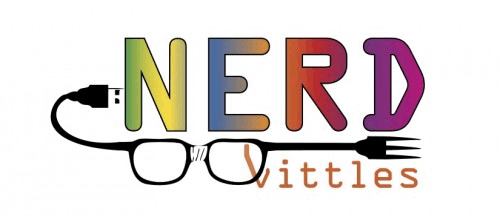
Need help with Asterisk? Visit the PBX in a Flash Forum.
Or Try the New, Free PBX in a Flash Conference Bridge.
whos.amung.us If you’re wondering what your fellow man is reading on Nerd Vittles these days, wonder no more. Visit our new whos.amung.us statistical web site and check out what’s happening. It’s a terrific resource for all of us.
Special Thanks to Our Generous Sponsors
FULL DISCLOSURE: ClearlyIP, Skyetel, Vitelity, DigitalOcean, Vultr, VoIP.ms, 3CX, Sangoma, TelecomsXchange and VitalPBX have provided financial support to Nerd Vittles and our open source projects through advertising, referral revenue, and/or merchandise. As an Amazon Associate and Best Buy Affiliate, we also earn from qualifying purchases. We’ve chosen these providers not the other way around. Our decisions are based upon their corporate reputation and the quality of their offerings and pricing. Our recommendations regarding technology are reached without regard to financial compensation except in situations in which comparable products at comparable pricing are available from multiple sources. In this limited case, we support our sponsors because our sponsors support us.
 BOGO Bonaza: Enjoy state-of-the-art VoIP service with a $10 credit and half-price SIP service on up to $500 of Skyetel trunking with free number porting when you fund your Skyetel account. No limits on number of simultaneous calls. Quadruple data center redundancy. $25 monthly minimum spend required. Tutorial and sign up details are here.
BOGO Bonaza: Enjoy state-of-the-art VoIP service with a $10 credit and half-price SIP service on up to $500 of Skyetel trunking with free number porting when you fund your Skyetel account. No limits on number of simultaneous calls. Quadruple data center redundancy. $25 monthly minimum spend required. Tutorial and sign up details are here.
 The lynchpin of Incredible PBX 2020 and beyond is ClearlyIP components which bring management of FreePBX modules and SIP phone integration to a level never before available with any other Asterisk distribution. And now you can configure and reconfigure your new Incredible PBX phones from the convenience of the Incredible PBX GUI.
The lynchpin of Incredible PBX 2020 and beyond is ClearlyIP components which bring management of FreePBX modules and SIP phone integration to a level never before available with any other Asterisk distribution. And now you can configure and reconfigure your new Incredible PBX phones from the convenience of the Incredible PBX GUI.
 VitalPBX is perhaps the fastest-growing PBX offering based upon Asterisk with an installed presence in more than 100 countries worldwide. VitalPBX has generously provided a customized White Label version of Incredible PBX tailored for use with all Incredible PBX and VitalPBX custom applications. Follow this link for a free test drive!
VitalPBX is perhaps the fastest-growing PBX offering based upon Asterisk with an installed presence in more than 100 countries worldwide. VitalPBX has generously provided a customized White Label version of Incredible PBX tailored for use with all Incredible PBX and VitalPBX custom applications. Follow this link for a free test drive!
 Special Thanks to Vitelity. Vitelity is now Voyant Communications and has halted new registrations for the time being. Our special thanks to Vitelity for their unwavering financial support over many years and to the many Nerd Vittles readers who continue to enjoy the benefits of their service offerings. We will keep everyone posted on further developments.
Special Thanks to Vitelity. Vitelity is now Voyant Communications and has halted new registrations for the time being. Our special thanks to Vitelity for their unwavering financial support over many years and to the many Nerd Vittles readers who continue to enjoy the benefits of their service offerings. We will keep everyone posted on further developments.
Some Recent Nerd Vittles Articles of Interest…
- Larry Page reportedly commented as follows: "I’ve personally been quite sad at the industry’s behavior around all these things. If you take something as simple as IM, we’ve had an open offer to interoperate forever. Just this week Microsoft took advantage of that by interoperating with us but not doing the reverse. Which is really sad and not the way to make progress. You can’t have people milking off of just one company for their own benefit…" [↩]
The Definitive VoIP Quick Start Guide: Introducing PBX in a Flash 2.0.6.4.3

Each time we release a new version of PBX in a Flash™, I’m reminded of one of my favorite childhood books and one of the best mottos of all time: "I Think I Can!" You can’t really appreciate what goes into an open source product like PBX in a Flash until you try doing it yourself. The sad part is we and the CentOS™ development team are part of a dwindling few non-commercial entities that still are in the open source "business." If you want to actually learn about Asterisk from the ground up using pure source code to customize your VoIP deployment, PBX in a Flash has no competition because your only other option is to roll your own starting with a Linux DVD. So our extra special kudos go to Tom King, who once again has produced a real masterpiece in that it is very simple for a first-time user to deploy and, at the same time, incredibly flexible for the most experienced Asterisk developer. The new PIAF 2.0.6.4.3 ISOs not only provide a choice of Asterisk® and FreePBX® versions to get you started. But now you can build and deploy standalone servers for SugarCRM™, NeoRouter™ VPN, and OpenFire™ XMPP using the 32-bit and 64-bit PIAF™ ISOs. So let’s get started, shall we?

Making a Hardware Selection
We’re going to assume that you need a VoIP telephony solution that will support an office of up to several dozen employees and that you have an Internet connection that will support whatever your simultaneous call volume happens to be. This is above and beyond your normal Internet traffic. To keep it simple, you need 100Kbps of bandwidth in both directions for each call.1 And you need a router/firewall that can prioritize VoIP traffic so that all your employees playing Angry Birds won’t cause degradation in VoIP call quality. Almost any good home router can now provide this functionality. Remember to disable ALG on your router, and it’s smooth sailing.
For computer hardware, you’ll need a dedicated machine. There are many good choices. Unless you have a burning desire to preserve your ties with Ma Bell, we recommend limiting your Ma Bell lines to your main number. Most phone companies can provide a service called multi-channel forwarding that lets multiple inbound calls to your main number be routed to one or more VoIP DIDs much like companies do with 800-number calls. If this works for you, then any good dual-core Atom computer will suffice. You’ll find lots of suggestions in this thread. And the prices generally are in the $200-$400 range. For larger companies and to increase Asterisk’s capacity with beefier hardware, see these stress test results.
If your requirements involve retention of dozens of Ma Bell lines and complex routing of calls to multiple offices, then we would strongly recommend you spend a couple thousand dollars with one of our consultants. They’re the best in the business, and they do this for a living. They can easily save you the cost of their services by guiding you through the hardware selection process. They also have turnkey phone systems using much the same technology as you’ll find in PBX in a Flash. You won’t hurt our feelings. ![]()
Choosing the Right PIAF Platform
We get asked this question about a hundred times a week on the forums so here goes. There are more than two dozen permutations and combinations of CentOS, Asterisk, and FreePBX to choose from when you decide to deploy PBX in a Flash. We always recommend the latest version of CentOS because it tends to be the most stable and also supports the most new hardware. You have a choice to make between a 32-bit OS or 64-bit. Our preference is the 32-bit platform because it is better supported. The performance difference is virtually unnoticeable for most VoIP applications. With Asterisk, we always recommend an LTS release because those have long-term support. That narrows your choices to Asterisk 1.8 or Asterisk 11. If you plan to use Digium® Phones (and we’ll get to that), then you’ll want either Certified Asterisk 1.8 or Asterisk 11. The conventional wisdom in the Asterisk community has been to avoid just released Asterisk versions like the plague. We think we’ve turned the corner on that approach. Asterisk 1.8 is close to end of life, and with Asterisk 11, you’re in great shape from a support standpoint for many years to come. We personally run Asterisk 11 and have yet to find something that functionally would qualify as a show stopper. That’s not to say there aren’t some bugs and security issues from time to time. A pretty serious collection of them was found a few months ago, but it affected all versions of Asterisk. So… our bottom line is that Asterisk 11 is the latest and greatest with the best feature set. If we were building a system for a commercial business, it would be our hands-down choice. In the PBX in a Flash world, we have colors for various versions of PBX in a Flash that support different versions of Asterisk. Asterisk 11 happens to be PIAF-Green, Asterisk 1.8=PIAF-Purple, Asterisk 10=PIAF-Red, Certified Asterisk 1.8=PIAF-Brown.
Choosing the Right Phones
If there is one thing that will kill any new VoIP deployment, it’s choosing the wrong phones. If you value your career, you’ll let that be an organization-driven decision after carefully reviewing at least 6-12 phones that won’t cause you daily heartburn. You and your budget team can figure out the price points that work in your organization keeping in mind that not everyone needs the same type of telephone. Depending upon your staffing, the issue becomes how many different phone sets are you and your colleagues capable of supporting and maintaining on a long term basis.
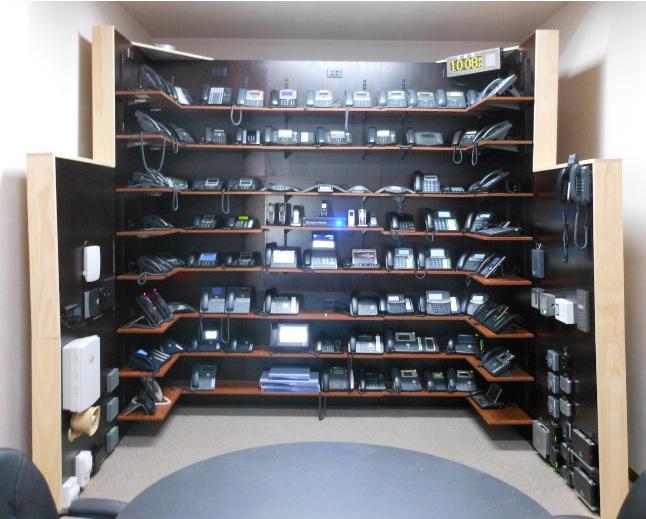
Schmooze Com has released a public beta of their commercial End Point Manager (EPM) at a price point of $25 per server. They’ve been using the application internally to support their commercial customers for over a year so it is not your typical beta software. Suffice it to say, it’s the best $25 you will ever spend. You can sign up for an account with Schmooze through our commercial support site and purchase the software now. After taking a look at the Admin User Guide, if you’re a true pioneer, drop us a note and we’ll get you a sneak peek. The beauty of this software is it gives you the flexibility to support over 150 different VoIP phones as well as other devices almost effortlessly. Using a browser, you can configure and reconfigure almost any phone on the market in a matter of minutes. So the question becomes which phones should you show your business associates. That again should be a decision by you and your management and budget teams, but collect some information from end-users first. Choose a half dozen representative users in your company and get each of them to fill out a questionnaire documenting their 10 most frequent daily phone calls and listing each step of how they processed those calls. That will give you a good idea about types and variety of phones you need to consider for different groups of users. Cheaper rarely is better. Keep in mind that phones can last a very long time, even lousy ones. So choose carefully.
The phone brands that we would seriously consider include Cisco, Aastra, Snom, Digium, Mitel, Polycom, Yealink, and Grandstream. Do you need BLF, call parking or multiple line buttons, a hold button, conferencing, speakerphone, HD voice, power over Ethernet support, distinctive ringtones for internal and various types of external calls, Bluetooth, WiFi, web, SMS, or email access, an extra network port for a computer, headset support, customizable buttons (how many?), quick dial keys, custom software, XML provisioning, VPN support? How easy is it to transfer a call? Do you need to mimic key telephones? Also consider color screens, touch screens, busy lamp indicators, extension modules (what capacity?). What do we personally use: several Digium phones of various types, a couple of Aastra phones, a Grandstream GXP2200, and a collection of Panasonic cordless DECT phones, a fax machine, and Samsung Galaxy Note II connected through an OBi202 with an OBiBT Bluetooth Adapter to our PIAF server.
Installing PBX in a Flash
With the office politics out of the way, let’s get to the fun stuff.
- Download PIAF 2.0.6.4.3 ISO from SourceForge
- Burn the ISO to a USB Thumb Drive or a DVD using a Mac or Windows machine
- Boot dedicated server using PIAF Flash Drive or DVD
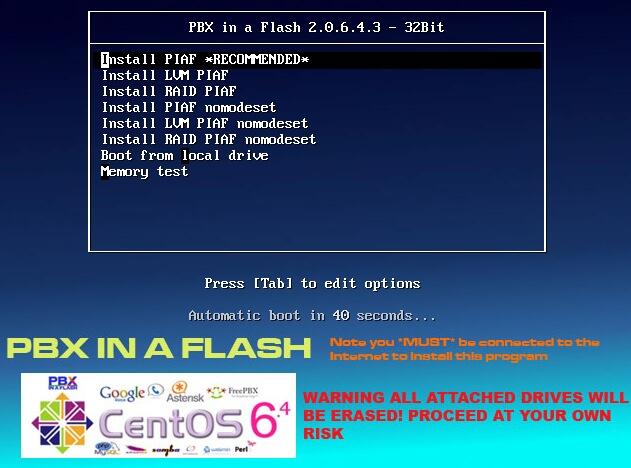
For most deployments, choose the default install by pressing Enter.
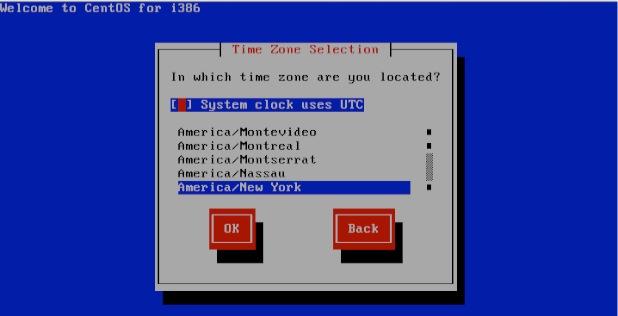
Leave the UTC System Clock option unchecked and pick your Time Zone. Tab to OK and press Enter.
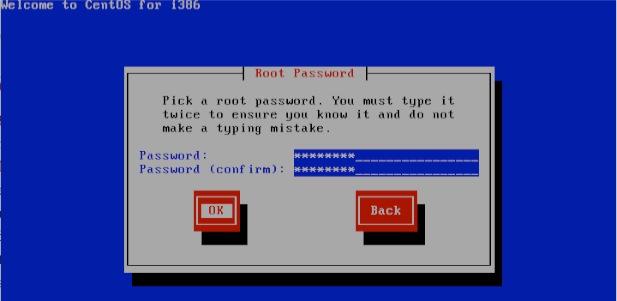
Choose a very secure Root Password. Tab to OK and press Enter. Your server will whir away for 5-10 minutes installing CentOS 6.4. When the reboot begins, remove the DVD or USB thumb drive.
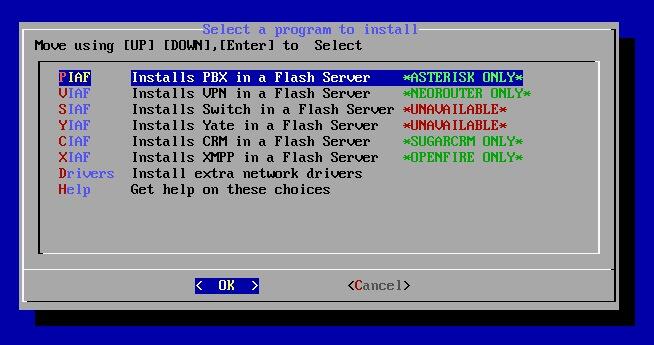
For today, we’re installing PBX in a Flash. So leave it highlighted, tab to OK, and press Enter.
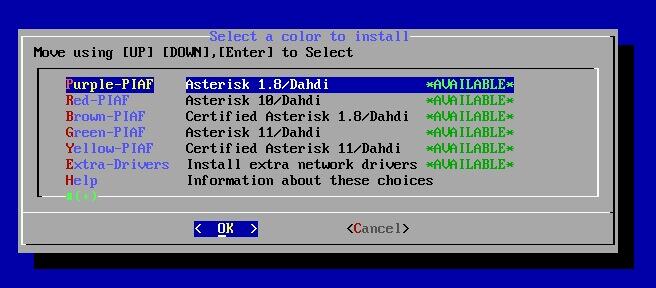
Now pick your PIAF flavor, tab to OK, and press Enter.

The PIAF Configuration Wizard will load. Press Enter to begin.
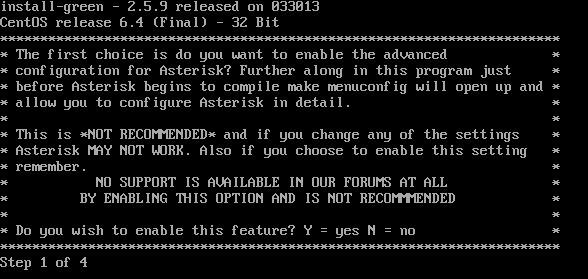
Unlike any other aggregation, PIAF gives you the opportunity to fully configure Asterisk using make menuconfig if you know what you’re doing. For everyone else, type N and then confirm your choice.

Next, you’ll need to choose your Time Zone again for PHP and FreePBX. Don’t worry if yours is missing. A new timezone-setup utility is available in /root to reconfigure this to any worldwide time zone.
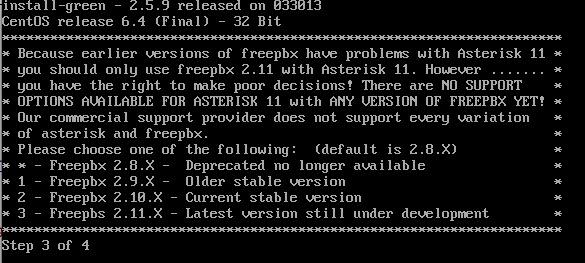
Next, choose your version of FreePBX to install. Ignore the screen info regarding Incredible PBX. It’s out of date. The following limitations apply if you plan to also install Incredible PBX and Incredible Fax:
Incredible PBX 3 requires PIAF-Purple and FreePBX 2.9
Incredible PBX 4 requires PIAF-Purple and FreePBX 2.10 (32-bit only)
Incredible PBX 11 requires PIAF-Green and FreePBX 2.11
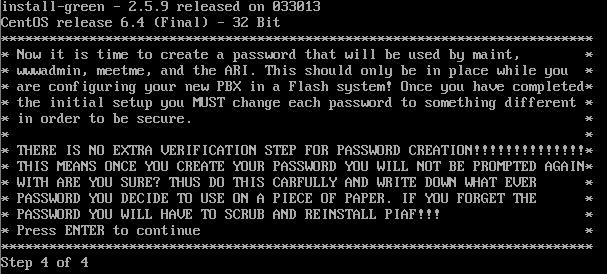
Finally, you need to choose a very secure maint password for access to FreePBX using a browser. You can pick your own, or the installer will generate one for you. Don’t forget it.
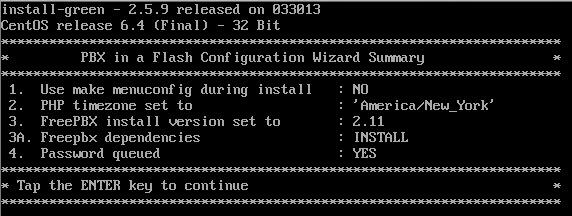
The installer will give you one last chance to make changes. If everything looks correct, press the Enter key and go have lunch. Be sure you have a working Internet connection to your server before you leave. ![]()
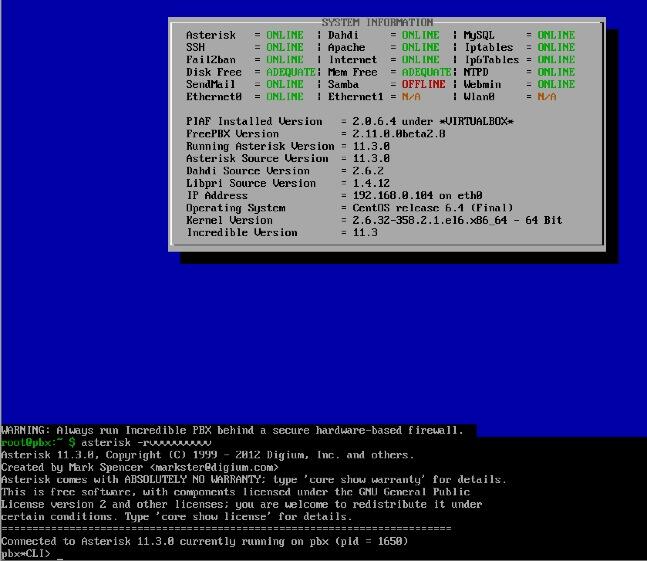
In about an hour, your server will reboot. You should be able to log in as root using your root password. Write down the IP address of your server from the status display (above) and verify that everything installed properly. Note that Samba is disabled by default. If you want to use your server with Windows Networking, run configure-samba once your server is up and running and you’ve logged in.
Configuring PBX in a Flash
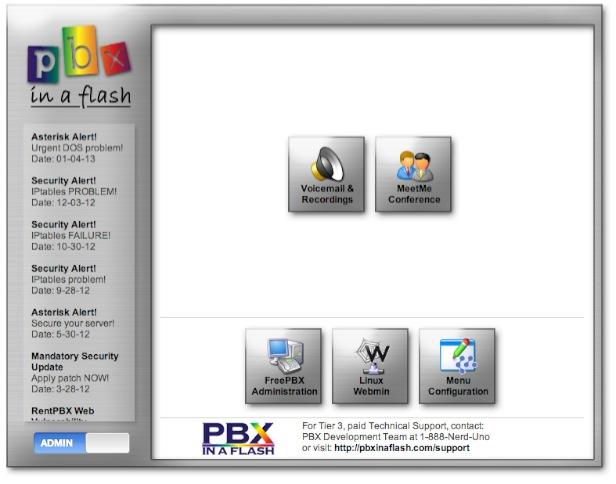
Most PIAF Configuration is accomplished using the FreePBX Web GUI. Point your browser to the IP address shown in the status display above to display your PIAF Home Page. Click on the Users tab. Click FreePBX Administration. When prompted for your username and password, the username is maint. The password will be the FreePBX master password you chose in the Config Module phase of the PBX in a Flash installation procedure above.
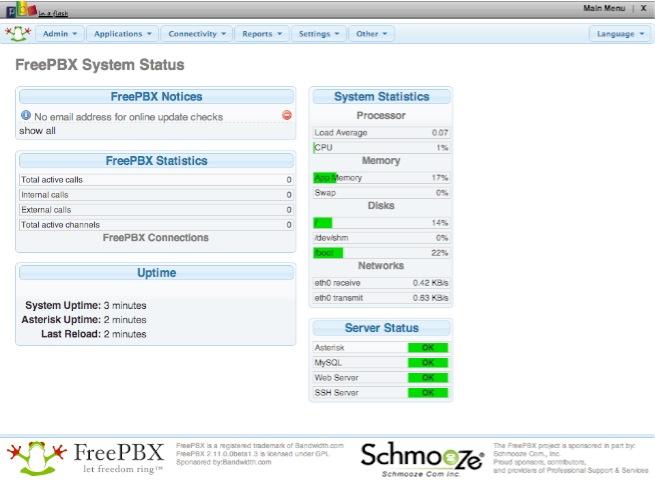
If you’re new to Asterisk and FreePBX, here’s the one paragraph primer on what needs to happen before you can make free calls with Google Voice. You’ll obviously need a free Google Voice account. This gets you a phone number for people to call you and a vehicle to place calls to plain old telephones throughout the U.S. and Canada at no cost. You’ll also need a softphone or SIP phone to actually place and receive calls. YATE makes a free softphone for PCs, Macs, and Linux machines so download your favorite and install it on your desktop. Phones connect to extensions in FreePBX to work with PBX in a Flash. Extensions talk to trunks (like Google Voice) to make and receive calls. FreePBX uses outbound routes to direct outgoing calls from extensions to trunks, and FreePBX uses inbound routes to route incoming calls from trunks to extensions to make your phones ring. In a nutshell, that’s how a PBX works. There are lots of bells and whistles that you can explore down the road. FreePBX now has some of the best documentation in the business. Start here.
To get a minimal system functioning to make and receive calls, here’s the 2-minute drill. You’ll need to set up at least one extension with voicemail, and we’ll configure a free Google Voice account for free calls in the U.S. and Canada. Next, we’ll set up inbound and outbound routes to manage incoming and outgoing calls. Finally, we’ll add a phone with your extension credentials.
A Few Words About Security. PBX in a Flash has been engineered to run on a server sitting safely behind a hardware-based firewall with NO port exposure from the Internet. Leave it that way! It’s your wallet and phone bill that are at stake. If you’re running PBX in a Flash in a hosted environment with no hardware-based firewall, then immediately read and heed our setup instructions for Securing Your VoIP in the Cloud Server. We would encourage you to visit your PIAF Home Page regularly. It’s our primary way of alerting you to security issues which arise. You’ll see them posted (with links) in the RSS Feed shown above. If you prefer, you can subscribe to the PIAF RSS Feed or follow us on Twitter. For late-breaking enhancements, you also should regularly visit the Bug Reporting & Fixes Topic on the PIAF Forum.
Extension Setup. Now let’s set up an extension to get you started. A good rule of thumb for systems with less than 50 extensions is to reserve the IP addresses from 192.x.x.201 to 192.x.x.250 for your phones. Then you can create extension numbers in FreePBX to match those IP addresses. This makes it easy to identify which phone on your system goes with which IP address and makes it easy for end-users to access the phone’s GUI to add bells and whistles. In FreePBX 2.10 or 2.11, to create extension 201 (don’t start with 200), click Applications, Extensions, Generic SIP Device, Submit. Then fill in the following blanks USING VERY SECURE PASSWORDS and leaving the defaults in the other fields for the time being.
User Extension … 201
Display Name … Home
Outbound CID … [your 10-digit phone number if you have one; otherwise, leave blank]
Emergency CID … [your 10-digit phone number for 911 ID if you have one; otherwise, leave blank]Device Options
secret … 1299864Xyz [randomly generated]
dtmfmode … rfc2833
Voicemail Status … Enabled
voicemail password … 14332 [make this unique AND secure!]
email address … yourname@yourdomain.com [if you want voicemail messages emailed to you]
pager email address … yourname@yourdomain.com [if you want to be paged when voicemail messages arrive]
email attachment … yes [if you want the voicemail message included in email]
play CID … yes [if you want the CallerID played when you retrieve message]
play envelope … yes [if you want date/time of the message played before the message]
delete Vmail … yes [if you want the voicemail message deleted after it’s emailed to you]
vm options … callback=from-internal [to enable automatic callbacks by pressing 3,2 after playing a voicemail message]
vm context … default
Write down the passwords. You’ll need them to configure your SIP phone.
Extension Security. We cannot overstress the need to make your extension passwords secure. All the firewalls in the world won’t protect you from malicious phone calls on your nickel if you use your extension number or something like 1234 for your extension password if your SIP or IAX ports happen to be exposed to the Internet.
In addition to making up secure passwords, the latest versions of FreePBX also let you define the IP address or subnet that can access each of your extensions. Use it!!! Once the extensions are created, edit each one and modify the permit field to specify the actual IP address or subnet of each phone on your system. A specific IP address entry should look like this: 192.168.1.142/255.255.255.255. If most of your phones are on a private LAN, you may prefer to use a subnet entry in the permit field like this: 192.168.1.0/255.255.255.0 using your actual subnet.
Adding a Google Voice Trunk. There are lots of trunk providers, and one of the real beauties of having your own PBX is that you don’t have to put all of your eggs in the same basket… unlike the AT&T days. We would encourage you to take advantage of this flexibility. With most providers, you don’t pay anything except when you actually use their service so you have nothing to lose.
For today, we’re going to take advantage of Google’s current offer of free calling in the U.S. and Canada through the end of 2013. You also get a free phone number in your choice of area codes. PBX in a Flash now installs a Google Voice module under FreePBX -> Connectivity that lets you set up your Google Voice account with PBX in a Flash in just a few seconds once you have your credentials.
A Word to the Wise: All good things come to an end… especially those that are free. So plan ahead with some alternate providers that keep your phones working should Google decide to pull the plug or change the terms with Google Voice.
Signing Up for Google Voice. You’ll need a dedicated Google Voice account to support PBX in a Flash. The more obscure the username (with some embedded numbers), the better off you will be. This will keep folks from bombarding you with unsolicited Gtalk chat messages, and who knows what nefarious scheme will be discovered using Google messaging six months from now. So keep this account a secret!
We’ve tested this extensively using an existing Gmail account rather than creating a separate account. Take our word for it. Inbound calling is just not reliable. The reason seems to be that Google always chooses Gmail chat as the inbound call destination if there are multiple registrations from the same IP address. So… set up a dedicated Gmail and Google Voice account2, and use it exclusively with PBX in a Flash. Google Voice no longer is by invitation only. If you’re in the U.S. or have a friend that is, head over to the Google Voice site and register. If you’re living on another continent, see MisterQ’s posting for some tips on getting set up.
You must choose a telephone number (aka DID) for your new account, or Google Voice calling will not work… in either direction. You also have to tie your Google Voice account to at least one working phone number as part of the initial setup process. Your cellphone number will work just fine. Don’t skip this step either. Just enter the provided confirmation code when you tell Google to place the test call to the phone number you entered. Once the number is registered, you can disable it if you’d like in Settings, Voice Setting, Phones. But…
IMPORTANT: Be sure to enable the Google Chat option as one of your phone destinations in Settings, Voice Setting, Phones. That’s the destination we need for PBX in a Flash to function with Google Voice! Otherwise, inbound and/or outbound calls will fail. If you don’t see this option, you may need to call up Gmail and enable Google Chat there first. Then go back to the Google Voice Settings and enable it. Be sure to try one call each way from Google Chat in Gmail. Then disable Google Chat in GMail for this account. Otherwise, it won’t work with PIAF.
While you’re still in Google Voice Settings, click on the Calls tab. Make sure your settings match these:
- Call Screening – OFF
- Call Presentation – OFF
- Caller ID (In) – Display Caller’s Number
- Caller ID (Out) – Don’t Change Anything
- Do Not Disturb – OFF
- Call Options (Enable Recording) – OFF
- Global Spam Filtering – ON
Click Save Changes once you adjust your settings. Under the Voicemail tab, plug in your email address so you get notified of new voicemails. Down the road, receipt of a Google Voice voicemail will be a big hint that something has come unglued on your PBX.
Configuring Google Voice Trunk in FreePBX. All trunk configurations now are managed within FreePBX, including Google Voice. This makes it easy to customize PBX in a Flash to meet your specific needs. Click the Connectivity tab in FreePBX 2.11 and choose Google Voice [Motif]. To Add a new Google Voice account, just fill out the form. NOTE: The form has changed from prior releases of FreePBX. Do NOT check the last box: Send Unanswered to GoogeVoice Voicemail, or you’ll have problems receiving incoming calls.
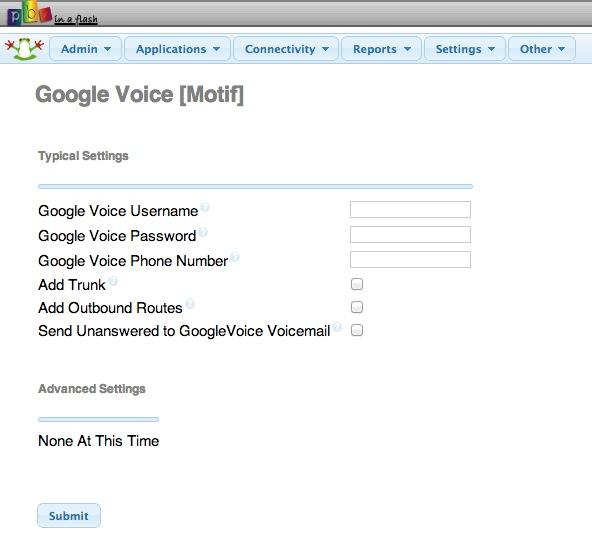
Google Voice Username is your Google Voice account name without @gmail.com. Password is your Google Voice password. NOTE: Don’t use 2-stage password protection in this Google Voice account! Phone Number is your 10-digit Google Voice number. Next, check only the first two boxes: Add Trunk and Add Outbound Routes. Then click Submit Changes and reload FreePBX. Down the road, you can add additional Google Voice numbers by clicking Add GoogleVoice Account option in the right margin and repeating the drill. For Google Apps support, see this post on the PIAF Forum.
Outbound Routes. The idea behind multiple outbound routes is to save money. Some providers are cheaper to some places than others. It also provides redundancy which costs you nothing if you don’t use the backup providers. The Google Voice module actually configures an Outbound Route for 10-digit Google Voice calling as part of the automatic setup. If this meets your requirements, then you can skip this step for today.
Inbound Routes. An Inbound Route tells PBX in a Flash how to route incoming calls. The idea here is that you can have multiple DIDs (phone numbers) that get routed to different extensions or ring groups or departments. For today, we’ll build a simple route that directs your Google Voice calls to extension 201. Choose Connectivity -> Inbound Routes, leave all of the settings at their default values except enter your 10-digit Google Voice number in the DID Number field. Enable CallerID lookups by choosing CallerID Superfecta in the CID Lookup Source pulldown. Then move to the Set Destination section and choose Extensions in the left pull-down and 201 in the extension pull-down. Now click Submit and save your changes. That will assure that incoming Google Voice calls are routed to extension 201.
IMPORTANT: Before Google Voice calling will actually work, you must restart Asterisk from the Linux command line interface. Log into your server as root and issue this command: amportal restart.
Eliminating Audio and DTMF Problems. You can avoid one-way audio on calls and touchtones that don’t work with these simple settings in FreePBX: Settings -> Asterisk SIP Settings. Just plug in your public IP address and your private IP subnet. Then set ULAW as the only Audio Codec.
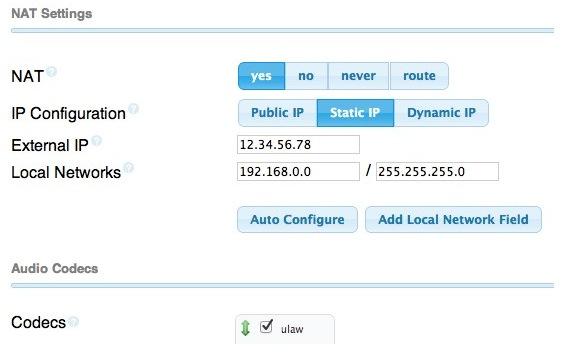
General Settings. Last, but not least, we need to enter an email address for you so that you are notified when new FreePBX updates are released. In FreePBX 2.11, choose Admin -> Module Admin and click on the Upgrade Notifications shield on the right. Plug in your email address, click Submit, and save your changes. Done!
Setting Up a Desktop Softphone. PBX in a Flash supports all kinds of telephones, but we’ll start with the easy (free) one today. You can move on to "real phones" once you’re smitten with the VoIP bug. For today, you’ll need to download a softphone to your desktop PC or Mac.
The easiest way to get started is to set up a YATE softphone on your Desktop computer. Versions are available at no cost for Macs, PCs, and Linux machines. Just download the appropriate one and install it from this link. Once installed, it’s a simple matter to plug in your extension credentials and start making calls. Run the application and choose Settings -> Accounts and click the New button. Fill in the blanks using the IP address of your server, 201 for your account name, and whatever password you created for the extension. Click OK.
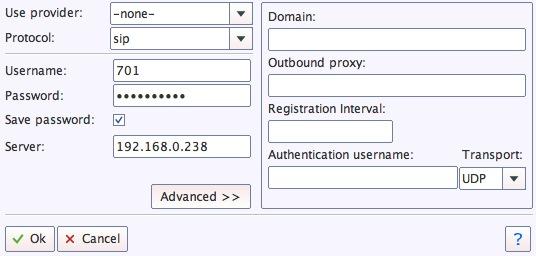
Once you are registered to extension 201, close the Account window. Then click on YATE’s Telephony Tab and place your first call. It’s that easy!
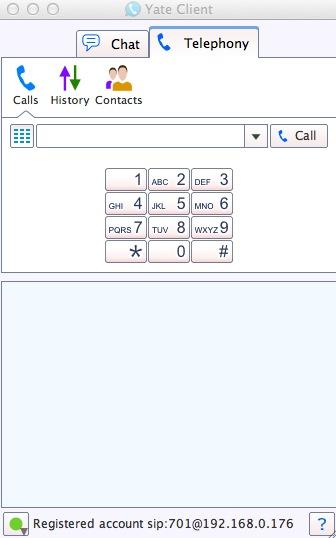
Monitoring Call Progress with Asterisk. That about covers the basics. We’ll leave you with a tip on how to monitor what’s happening with your PBX. There are several good tools within the FreePBX GUI. You’ll find them under the Reports tab. In addition, Asterisk has its own Command Line Interface (CLI) that is accessible from the Linux command prompt. Just execute the following command while logged in as root: asterisk -rvvvvvvvvvv.
What’s Next? We’ve barely scratched the surface of what you can do with PBX in a Flash. Log into your server as root and type help-pbx for a list of simple install scripts that can add almost any function you can imagine. And Incredible PBX 11 and Incredible Fax can be installed in under 2 minutes to provide you almost every Asterisk application on the planet. You can read the complete tutorial here.
New App of the Week. We’re pleased to introduce Trunk Failure Email Alerts for Asterisk supporting SIP, IAX2, and Google Motif trunks. Just insert your email address in this little script and run it every hour as a cron job. You’ll get an email alert whenever any of your VoIP trunks fail. Enjoy!

Originally published: Friday, April 19, 2013

Need help with Asterisk? Visit the PBX in a Flash Forum.
Or Try the New, Free PBX in a Flash Conference Bridge.
whos.amung.us If you’re wondering what your fellow man is reading on Nerd Vittles these days, wonder no more. Visit our new whos.amung.us statistical web site and check out what’s happening. It’s a terrific resource both for us and for you.
Special Thanks to Our Generous Sponsors
FULL DISCLOSURE: ClearlyIP, Skyetel, Vitelity, DigitalOcean, Vultr, VoIP.ms, 3CX, Sangoma, TelecomsXchange and VitalPBX have provided financial support to Nerd Vittles and our open source projects through advertising, referral revenue, and/or merchandise. As an Amazon Associate and Best Buy Affiliate, we also earn from qualifying purchases. We’ve chosen these providers not the other way around. Our decisions are based upon their corporate reputation and the quality of their offerings and pricing. Our recommendations regarding technology are reached without regard to financial compensation except in situations in which comparable products at comparable pricing are available from multiple sources. In this limited case, we support our sponsors because our sponsors support us.
 BOGO Bonaza: Enjoy state-of-the-art VoIP service with a $10 credit and half-price SIP service on up to $500 of Skyetel trunking with free number porting when you fund your Skyetel account. No limits on number of simultaneous calls. Quadruple data center redundancy. $25 monthly minimum spend required. Tutorial and sign up details are here.
BOGO Bonaza: Enjoy state-of-the-art VoIP service with a $10 credit and half-price SIP service on up to $500 of Skyetel trunking with free number porting when you fund your Skyetel account. No limits on number of simultaneous calls. Quadruple data center redundancy. $25 monthly minimum spend required. Tutorial and sign up details are here.
 The lynchpin of Incredible PBX 2020 and beyond is ClearlyIP components which bring management of FreePBX modules and SIP phone integration to a level never before available with any other Asterisk distribution. And now you can configure and reconfigure your new Incredible PBX phones from the convenience of the Incredible PBX GUI.
The lynchpin of Incredible PBX 2020 and beyond is ClearlyIP components which bring management of FreePBX modules and SIP phone integration to a level never before available with any other Asterisk distribution. And now you can configure and reconfigure your new Incredible PBX phones from the convenience of the Incredible PBX GUI.
 VitalPBX is perhaps the fastest-growing PBX offering based upon Asterisk with an installed presence in more than 100 countries worldwide. VitalPBX has generously provided a customized White Label version of Incredible PBX tailored for use with all Incredible PBX and VitalPBX custom applications. Follow this link for a free test drive!
VitalPBX is perhaps the fastest-growing PBX offering based upon Asterisk with an installed presence in more than 100 countries worldwide. VitalPBX has generously provided a customized White Label version of Incredible PBX tailored for use with all Incredible PBX and VitalPBX custom applications. Follow this link for a free test drive!
 Special Thanks to Vitelity. Vitelity is now Voyant Communications and has halted new registrations for the time being. Our special thanks to Vitelity for their unwavering financial support over many years and to the many Nerd Vittles readers who continue to enjoy the benefits of their service offerings. We will keep everyone posted on further developments.
Special Thanks to Vitelity. Vitelity is now Voyant Communications and has halted new registrations for the time being. Our special thanks to Vitelity for their unwavering financial support over many years and to the many Nerd Vittles readers who continue to enjoy the benefits of their service offerings. We will keep everyone posted on further developments.
Some Recent Nerd Vittles Articles of Interest…
Introducing The Eighth Wonder: Incredible PBX 3.11 for the $35 Raspberry Pi
 It’s been a wild ride with the $35 Raspberry Pi®. In addition to our tens of thousands of Happy Campers around the world, we now have nearly a dozen friends in our little neighborhood using a Raspberry Pi as their primary phone system. Can you believe it? The Raspberry Pi Foundation has already sold more than a million of these devices. If you’re new to the party, imagine squeezing a 700 mHz ARM processor with 512MB of RAM, 2 USB ports, a 10/100 Ethernet port, an HDMI port, composite video, a separate audio jack, an SDHC card slot, and a micro USB port onto a motherboard the size of a credit card weighing 1.6 ounces.
It’s been a wild ride with the $35 Raspberry Pi®. In addition to our tens of thousands of Happy Campers around the world, we now have nearly a dozen friends in our little neighborhood using a Raspberry Pi as their primary phone system. Can you believe it? The Raspberry Pi Foundation has already sold more than a million of these devices. If you’re new to the party, imagine squeezing a 700 mHz ARM processor with 512MB of RAM, 2 USB ports, a 10/100 Ethernet port, an HDMI port, composite video, a separate audio jack, an SDHC card slot, and a micro USB port onto a motherboard the size of a credit card weighing 1.6 ounces.
[iframe-popup id="3″]
Absolute perfection. Other than the slow write speeds to the sd card (you might add a warning note about that part), I had it swapped over to local extension numbers and trunked to existing asterisk servers in minutes… [I]t doesn’t get any cooler than this! — Scott P.
Trust us when we say the performance of this $35 computer is nothing short of amazing. Can it do everything a $300 dual-core Atom PC can do? No. Can it do 90% of everything for someone whose requirements do not exceed several simultaneous calls at a time but still wants a full-blown PBX for call routing, voicemail, IVRs, music on hold, and text-to-speech and speech-to-text apps for a home, a SOHO office, a Little League team, or a dorm room? Absolutely. As Scott mentioned, configuration changes may take you a few seconds longer than would normally be the case with an Atom-based PC and a hard disk. But, hey, you’re performing this magic on a $35 computer!
We’re now at the six-month mark with this project, and today we’re pleased to introduce Incredible PBX 3.11 for the Raspberry Pi featuring the very latest Asterisk 11 and FreePBX 2.11 versions for a near perfect telephony platform. Special thanks to the 300 pioneers that have given five iterations of this new release a healthy workout over the past few weeks.
What’s New in Incredible PBX 3.11. For those of you already running a previous version, here’s a quick thumbnail of the 3.11 feature set. As in the past, we’ve tried to mimic as much of the previous build functionality as possible. So you still get simple utilities to configure 1GHz overclocking and automatic expansion of the 3.11 image to run on any size SDHC card. But the major addition is implementation of Asterisk’s latest long-term support release, Asterisk 11, which provides a much more stable platform particularly for applications such as Google Voice. There’s also been major plumbing enhancements in FreePBX 2.11 to improve its stability and to enhance security. Of course, you still get Google Voice support for free calling in the U.S. and Canada as well as free faxing and SMS messaging plus most of the Incredible PBX feature set. If you’re one of the early pioneers that has an original 256MB Raspberry Pi, we would encourage you to plunk down another $35 for the 512MB version. The performance difference is amazing. And it makes a much more stable platform for Incredible PBX 3.11 and Incredible Fax.
UPDATE: As of 1 PM EDT on April 1, there’s new kernel and firmware support for the very latest Raspberry Pi boards.
Now for the bad news. There’s really no way to upgrade a previous Incredible PBX build to 3.11. There simply were too many under-the-covers modifications to make this feasible. Upgrading Asterisk alone is a 2+ hour knuckle drill on the Raspberry Pi, and we’ve made hundreds of additional tweaks to take advantage of the new platform. If your current system meets your needs, keep it. If you’re just getting started or like to tinker, move up to Incredible PBX 3.11.
Incredible PBX 3.5 and beyond added automatic detection and support of 512MB Raspberry Pi devices without touching anything. Beginning with version 3.7, we added an awesome fax server to Incredible PBX for those with a 512MB board. The complete tutorial is available here. update-my-pi in the /root folder of your server helps to safeguard your system by bringing it up to date with the latest fixes and enhancements. After running it the first time, it gets run automatically whenever you log in as root. For the safety of your server, don’t disable it! It’s free for the first ten updates, and then it’s just $20 a year. We have to eat, too. If you are philosophically opposed to ever spending a dime to support the open source movement, then feel free to load the latest version of Incredible PBX at no cost whenever you like. It will always be free! Then you can restore your settings using the backup and restore feature built into FreePBX.
To enable overclocking at your own risk, run: raspi-config. Overclocking works for us. YMMV! The key is a good power supply. If you’re using an SD card larger than 4GB, version 3.3 and beyond now can resize your partitions on the fly. Just choose the option in raspi-config and reboot. Even though the kernel now monitors CPU temperature and manages overclocking, it’s always nice to see for yourself. To monitor the CPU temperature, just run the status program which provides a current snapshot anytime. Temperature data now is provided on the FreePBX Dashboard as well.
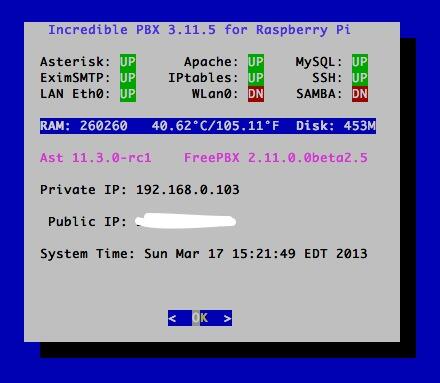
There’s more good news. Networking is much more stable; however, we’ve dropped support for the TP-Link WiFi adapters. If you still have one of these adapters, see this thread on the PIAF Forum for setup instructions. Otherwise you’ll need the recommended AirLink 101 N-150 if you want WiFi capability. In the 3.11 release, your server will automatically attempt to connect to any open WiFi network that it can find. We’ve also added two scripts in /root to let you restart either your wired or wireless network and designate it as the primary network: restart-eth0 and restart-wlan0. Time zone management was also a bit of mess with multiple file settings required to support both Linux and PHP. In the 3.11 release, you’ll be prompted to select your timezone when you first log in as root. The setup script will automatically apply your entry in all the right places. We’ve also replaced SendMail with Exim to simplify the process of using an SMTP mail gateway such as Gmail. We’ve documented the procedure for making the change here.
As part of the 3.11 migration, we’ve also eliminated the pi user account. Everything you need to do to configure Incredible PBX requires root permission. So goodbye sudo. Only the root user account is included, and the default password is raspberry. Change the password when you first log in. New SSH and DUNDI keys now are automatically generated when you first boot your server. The FreePBX Backup and Restore Utility is included in this new build. AsteriDex Speed Dialing has been enhanced for our friends across the Atlantic. Enter 3-digit Dial Codes in AsteriDex, and you can call by dialing 000nnn. In the 3.11 upgrade, Telephone Reminders again work.
X Windows is included in this build. This won’t work with SSH. For a demo slideshow, plug in a real monitor and log in as root. In the /root folder, enter the command: startx. To end the slideshow, press ESCape. To disable the slideshow: mv .xinitrc xinitrc. To add photos, copy .jpg images into /root/slideshow. No mouse is required for the slideshow but, if you run X Windows natively, you’ll need a USB mouse. The SMS Blasting app in /root now supports phone numbers (which use SMS) and email addresses (which use SendMail).
Last but not least, a sophisticated Conference Bridge has been added to Incredible PBX 3.11. If you route one of your inbound DIDs to the predefined IVR, users can press 0 and enter 1234 for the conference PIN to join the conference. Local extensions simply dial C-O-N-F. We’ve already tested a 9-person conference call with excellent results. But don’t take our word for it. Try it for yourself. Just call our demo Raspberry Pi AutoAttendant and take the Conference Bridge and a handful of other Incredible PBX™ apps for a test drive:

And here’s what the conference call looked like in the FreePBX Dashboard:

So you don’t have to jump around between articles, we’ve put together this Quick Start Guide that tells you everything you need to know to get up and running in about an hour. Most of that time will be consumed copying the Incredible Pi image to an SD card. So there’s plenty of time for lunch during the hour. Once your system is running and you’ve completed the setup steps below, then jump over to the application tutorial which explains how to use every one of the 35+ Incredible PBX Apps for the $35 Raspberry Pi.
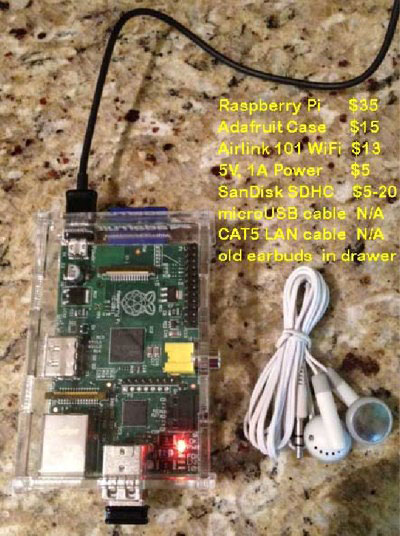
What to Buy. Here’s everything you need to get started.1 The case is optional. Yes, you can run the Raspberry Pi sitting on your desk with no case. It’s only 5 volts. WiFi is also optional. There’s a 10/100 port on the Raspberry Pi that gives you all the networking you need. Here are the links to buy the pieces. You also need a CAT5 cable and either a spare PC or Mac with Putty or SSH and a pair of earbuds or an HDMI cable to connect to a TV or monitor and a USB keyboard.
- $35 512MB Raspberry Pi from MCM or Newark or Amazon
- $10 Power Adapter (this one is rock solid!)
- $10 SanDisk 16GB SDHC Type 4 card
- $15 Adafruit Acrylic Case
- $13 AirLink 101 N150 WiFi Adapter or Adafruit Mini WiFi Adapter
Setting Up Google Voice. If you want free calling in the U.S. and Canada, then you’ll need a Google Voice account, and you’ll need one dedicated to Incredible Pi, or it won’t work. Log out after setting up the new Google Voice account!
- Register for Google Voice account (no funky characters in your password!)
- Enable Google Chat as Phone Destination
- Configure Google Voice Calls Settings:
- Call Screening – OFF
- Call Presentation – OFF
- Caller ID (In) – Display Caller’s Number
- Caller ID (Out) – Don’t Change Anything
- Do Not Disturb – OFF
- Call Options (Enable Recording) – OFF
- Global Spam Filtering – ON
- Place test call in and out using GMail Call Phone
Baking Your Incredible Pi. The disk drive for the Raspberry Pi is an SD card. So what you need to do is download Incredible Pi and copy the image onto an SDHC card. Mac and Linux installers are included. For Windows, just use Win32 Disk Imager. Here are the steps:
- Download the Incredible Pi package
- Decompress the tarball: tar zxvf incrediblepi-version.tar.gz
- Copy .img file to SDHC using image utility or script
- Insert SDHC card into Raspberry Pi
- Boot the Raspberry Pi from Incredible Pi SDHC card
Your First Bite of Incredible Pi. If you’re not using a monitor and keyboard, you can use SSH to gain root access to Incredible Pi. And you can use any web browser on your private network to access your server. There are a couple of hurdles. First, you need the network address of your new server. And, second you need an SSH client. With Incredible PBX 3.3 and beyond, you needn’t worry about the IP address. You now can access your server via SSH by logging in like this: root@incrediblepbx.local. And browser access to your server is available at the following address: http://incrediblepbx.local. You still can plug in some earbuds when the bootup process begins and listen for the Incredible Pi to tell you its IP address when the boot procedure completes (about 90 seconds). Then you can use that IP address instead of incrediblepbx.local. The latest releases of Incredible PBX also include a Java-based SSH client in the FreePBX web GUI: Admin -> Java SSH. Because of the almost weekly security problems with Java, we strongly recommend using a standalone SSH client such as Putty.
Here’s everything you need to know about security for Incredible Pi:
1. ALWAYS RUN INCREDIBLE PI BEHIND A SECURE HARDWARE-BASED FIREWALL/ROUTER
2. NEVER EXPOSE ANY INCREDIBLE PI PORTS DIRECTLY TO THE INTERNET
3. NEVER MAP INBOUND INTERNET PORTS FROM YOUR FIREWALL TO INCREDIBLE PI
Initial Setup. There also are a few setup steps to complete once your Incredible Pi finishes the bootup process. When you first login (username: root password: raspberry), you’ll be prompted to change your root password and to set your default time zone. If you’re using either a wired network or an open WiFi network, then everything just works. If you’re using secured WiFi, then you’ll need to plug in your credentials in /etc/wpa.conf and reboot. The wired network always takes precedence so unplug the cable if you want WiFi to be your primary network. /root/update-my-pi runs automatically when you log in as root. It will bring your server up to current specs. Finally, now’s the time to repartition your SD card if you’re using a card larger than 4GB (highly recommended!). While you’re at it, bump up the performance of your Raspberry Pi by 50% by setting the overclocking to turbo mode. It works great for us. YMMV! The key is a rock-solid power adapter such as the one we’ve recommended. Just run raspi-config and follow your nose.
Accessing Incredible Pi By GUI. You don’t have to be a Linux guru to use Incredible Pi. In fact, we’re just about finished with the Linux command prompt, but stay logged in until we finish the steps below. Most of your configuration of the PBX will be performed using the FreePBX® Web GUI.
If you’re new to Asterisk® and FreePBX, here’s the one paragraph primer on what needs to happen before you can make free calls with Google Voice. You’ll obviously need a free Google Voice account. This gets you a phone number for people to call you and a vehicle to place calls to plain old telephones throughout the U.S. and Canada at no cost. You’ll also need a softphone or SIP phone to actually place and receive calls. YATE makes a free softphone for PCs, Macs, and Linux machines so download your favorite and install it on your desktop. Phones connect to extensions in FreePBX to work with Incredible Pi. Extensions talk to trunks (like Google Voice) to make and receive calls. FreePBX uses outbound routes to direct outgoing calls from extensions to trunks, and FreePBX uses inbound routes to route incoming calls from trunks to extensions to make your phones ring. In a nutshell, that’s how a PBX works. There are lots of bells and whistles that you can explore down the road.
Let’s get started. Using a browser, enter the IP address of your server or just use incrediblepbx.local as the address. Choose FreePBX Administration. When prompted for a username and password, use admin for both. Here are the six steps you need to complete before making your first free call:
- Change FreePBX admin Password and Default Email
- Add Google Voice Account credentials
- Set Destination for Incoming Calls
- Change Extension 701 Passwords
- Eliminate Audio and DTMF Problems
- Install and Register a Softphone to Extension 701
1. Changing FreePBX admin Password and Default Email. From the main FreePBX GUI, click Admin => Administrators. Click on admin user in the far-right column. Enter a new Password and click Submit Changes button. Then click the Apply Config button. Next, set your default email address in the right margin of Admin -> Module Admin and save your entry.
2. Activating a Google Voice Trunk. To create a Trunk in FreePBX to handle calls to and from Google Voice, you’ll need three pieces of information from the Google Voice account you set up above: the 10-digit Google Voice phone number, your Google Voice account name, and your Google Voice password. Choose Connectivity -> Google Voice (Motif) from the FreePBX GUI. The following form will appear:
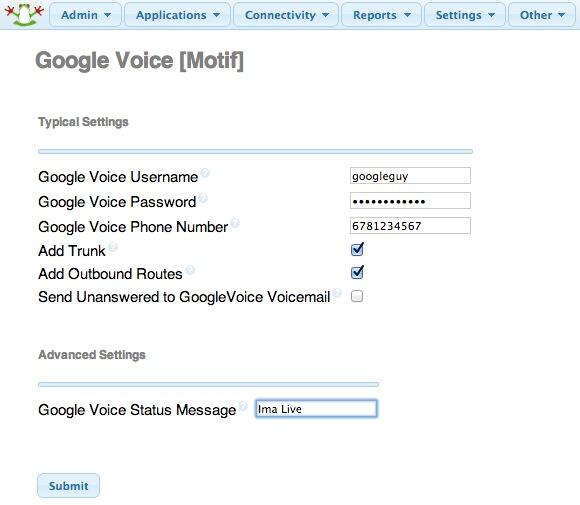
Fill in the blanks with your information and check only the top 2 boxes. If your Google Voice account name ends in @gmail.com, leave that out. Otherwise, include the full email address. Then click Submit Changes and Apply Config.
There’s one more step or your Google Voice account won’t work reliably with Incredible Pi! From the Linux command prompt while logged into your server as root, restart Asterisk: amportal restart
3. Setting a Destination for Incoming Calls. Now that you’ve created your Google Voice Trunk, we need to tell FreePBX how to process inbound calls when someone dials your Google Voice number. There are any number of choices. You could simply ring an extension. Or you could ring multiple extensions by first creating a Ring Group which is just a list of extension numbers. Or you could direct incoming calls to an Interactive Voice Response (IVR) system (we’ve actually set one up for you to play with).
By default, Incredible Pi is configured to route all incoming calls to a demo IVR that shows off some of the applications that come with Incredible Pi. You can change whenever you like by choosing Connectivity -> Inbound Routes -> Default. In the Set Destination section of the form, change the target to Extensions and then select 701 from the list. Then click Submit and Apply Config.
4. Changing Extension Passwords. From the main FreePBX GUI, choose Applications -> Extensions. Then click on 701 in the Extension List on the right side of your display. You’ll see a form that looks like this:

For now, we only need to make a few changes. First, you need a very secure password for both the extension itself and your voicemail account for this extension. The extension secret needs to be a combination of letters and numbers. The Voicemail Password needs to be all numbers, preferably six or more. Replace the existing 1234secret and 1234 with your own (very secure) entries. You also need to lock down this extension so that it is only accessible from devices on your private LAN. You do that with the deny and permit entries which currently are filled with zeroes. Leave the deny entry the way it is which tells Incredible Pi to block everybody except those allowed in the permit entry below. For the permit, we need the first three octets of your private LAN address, e.g. if your LAN is 192.168.0.something then the permit entry will be 192.168.0.0/255.255.255.0.
Finally, you need to plug in your actual email address in the Voicemail section so that voicemails can be delivered to you when someone leaves a message. You can also include a pager email address if you want a text message alert with incoming voicemails. If you want the voicemails to automatically be deleted from the server after they are emailed to you (a good idea considering the disk storage limitations of an SDHC card), change the Delete Voicemail option from No to Yes. That’s it. Now save your settings by clicking the Submit button. Then reload the dialplan by clicking on the red prompt when it appears.
In case you’re curious, unless you’ve chosen to automatically delete voicemails after emailing them, you can retrieve your voicemails by dialing *98701 from any extension on your phone system. You’ll be prompted to enter the voicemail password you set up. In addition to managing your voicemails, you’ll also be given the opportunity to either return the call to the number of the person that called or to transfer the voicemail to another extension’s voicemail box. And you can always leave a voicemail for someone by dialing their extension number preceded by an asterisk, e.g. *701 would let someone leave you a voicemail without actually calling you.
5. Eliminating Audio and DTMF Problems. You can avoid one-way audio on calls and touchtones that don’t work with these simple settings in FreePBX: Settings -> Asterisk SIP Settings. Just plug in your public IP address and your private IP subnet. Then set ULAW as the only Audio Codec.

6. Setting Up a Desktop Softphone. Incredible Pi supports all kinds of telephones, but we’ll start with the easy (free) one today. You can move on to "real phones" once you’re smitten with the VoIP bug. For today, you’ll need to download a softphone to your desktop PC or Mac.
As we mentioned, the easiest way to get started with Incredible Pi is to set up a YATE softphone on your Desktop computer. Versions are available at no cost for Macs, PCs, and Linux machines. Just download the appropriate one and install it from this link. Once installed, it’s a simple matter to plug in your extension 701 credentials and start making calls. Run the application and choose Settings -> Accounts and click the New button. Fill in the blanks using the IP address of Incredible Pi, 701 for your account name, and whatever password you created for the extension. Click OK.

Once you are registered to extension 701, close the Account window. Then click on YATE’s Telephony Tab and place your first call. It’s that easy!

Monitoring Call Progress with Asterisk. That about covers the basics. We’ll leave you with a tip on how to monitor what’s happening with your PBX. There are several good tools within the FreePBX GUI. You’ll find them under the Reports tab. In addition, Asterisk has its own Command Line Interface (CLI) that is accessible from the Linux command prompt. Just execute the following command while logged in as root: asterisk -rvvvvvvvvvv.
Activating SAMBA for Windows Networking. SAMBA is included for transparent access using the Windows Networking Protocol from PCs, Macs, and other Linux machines. As delivered, SAMBA is deactivated. For obvious reasons, we recommend you never activate root login access to SAMBA without a very secure password. If you wish to enable SAMBA on your server, here are the steps while logged in as root:
- 1. Set SAMBA password for user root: smbpasswd -a root
- 2. Change Windows workgroup from WORKGROUP, if needed: nano -w /etc/samba/smb.conf
- 3. Manually start SAMBA from command prompt: service samba start
- 4. If desired, set SAMBA to start on boot: rcconf and activate SAMBA option
Activating the PPTP VPN Client. If you’ve followed the Nerd Vittles tutorial and previously set up a PPTP VPN Server for your devices, then it’s pretty simple to add Incredible Pi to the mix by activating its PPTP VPN client. You’ll need the FQDN or public IP address of your VPN server as well as a username and password for VPN access to your VPN server. Once you have those in hand, log into Incredible Pi as root.
Lest we forget to mention, you cannot log into your PPTP server from an IP address on the same private LAN so you’d only use the PPTP VPN when your Incredible Pi is at a remote location.
Edit the connection template: nano -w /etc/ppp/peers/my-pptp-server. Insert the following text and replace myfqdn.org with the FQDN of your PPTP server, replace myname with your PPTP username, and replace mypassword with your PPTP password. Then save the file: Ctrl-X, Y, then Enter.
To test it, issue the following command: /etc/init.d/pptp start. When you run ifconfig, you should now see a ppp0 entry:
ppp0 Link encap:Point-to-Point Protocol
UP POINTOPOINT RUNNING NOARP MULTICAST MTU:1500 Metric:1
RX packets:0 errors:0 dropped:0 overruns:0 frame:0
TX packets:0 errors:0 dropped:0 overruns:0 carrier:0
collisions:0 txqueuelen:3
RX bytes:0 (0.0 B) TX bytes:0 (0.0 B)
Remember, it won’t show an IP address if the Raspberry Pi and your PPTP VPN Server are on the same subnet (like ours). Once you install your Raspberry Pi in a remote location, you now can access it at the first IP address in your reserved PPTP IP address pool.
To permanently activate the PPTP VPN client on your Incredible Pi server, run rcconf. Scroll to the bottom of the list and highlight pptp. Press the space bar to select it for automatic startup when you boot your server. Then tab to OK and press Enter.
Activating Incredible Fax. With a 512MB Raspberry Pi, here are the 5 Simple Steps to activate Incredible Fax. The original tutorial is available here.
- Download and Install Incredible PBX 3.11
- Run the /root/fax-enable Script to Automatically Configure HylaFax
- Using FreePBX, Add Additional, Dedicated DID and Inbound Route to Handle Incoming Faxes
- Install Any Desktop HylaFax Client to Send Faxes via Print-to-Fax using any PDF
- Reboot Your Server and Enjoy
Incredible Trunks. When you’re ready to try some other SIP providers, here is a quick Cheat Sheet courtesy of Kristian Hare, who translated our original setups into a spreadsheet. Just click on the image below to open it in a new window. Then click on the redisplayed image to enlarge it.

Configuring CallerID Superfecta. In order to match names with phone numbers, Incredible PBX includes a FreePBX application named CallerID Superfecta. Out of the box, Incredible PBX 3.11 will work fine if you remember to activate CallerID Superfecta whenever you create a new Inbound Route. The CNAM entries also will be displayed in your CDR reports. For those not in the United States, you may prefer to use a lookup source for your numbers other than the ones preconfigured in CallerID Superfecta. You will find all of the available modules on the POSSA GitHub site. Just download the ones desired into /var/www/html/admin/superfecta/sources and then activate the desired sources in Admin -> CID Superfecta -> Default. You can test your results and the performance using the Debug facility that’s built into the module.
Shutting Down Your Server. Last but not least, never just pull the plug when you want to shut down your server, or you may end up with corrupted MySQL databases. Then nothing will run. Instead, log into your server as root, and issue the following command: shutdown -h now. Enjoy!
Where To Go Next. Once you’ve done a little exploring, take a few minutes to read the complete tutorial on all 35 Incredible PBX applications for Raspberry Pi. A few require a bit of configuration before you start using them. And then you’ll want to explore Interconnecting Asterisk Servers with Incredible PBX and the Raspberry Pi. Enjoy!
 Don’t forget to List Yourself in Directory Assistance so everyone can find you by dialing 411. And add your new number to the Do Not Call Registry to block telemarketing calls. Or just call 888-382-1222 from your new number.
Don’t forget to List Yourself in Directory Assistance so everyone can find you by dialing 411. And add your new number to the Do Not Call Registry to block telemarketing calls. Or just call 888-382-1222 from your new number.
Originally published: Monday, March 18, 2013
 Support Issues. With any application as sophisticated as this one, you’re bound to have questions. Blog comments are a terrible place to handle support issues although we welcome general comments about our articles and software. If you have particular support issues, we encourage you to get actively involved in the PBX in a Flash Forums. It’s the best Asterisk tech support site in the business, and it’s all free! In fact, there is an entire forum dedicated to support of Incredible PBX for the Raspberry Pi. Please have a look and post your support questions there. Unlike some forums, ours is extremely friendly and is supported by literally hundreds of Asterisk gurus and thousands of ordinary users just like you. You won’t have to wait long for an answer to your question.
Support Issues. With any application as sophisticated as this one, you’re bound to have questions. Blog comments are a terrible place to handle support issues although we welcome general comments about our articles and software. If you have particular support issues, we encourage you to get actively involved in the PBX in a Flash Forums. It’s the best Asterisk tech support site in the business, and it’s all free! In fact, there is an entire forum dedicated to support of Incredible PBX for the Raspberry Pi. Please have a look and post your support questions there. Unlike some forums, ours is extremely friendly and is supported by literally hundreds of Asterisk gurus and thousands of ordinary users just like you. You won’t have to wait long for an answer to your question.

Need help with Asterisk? Visit the PBX in a Flash Forum.
Special Thanks to Our Generous Sponsors
FULL DISCLOSURE: ClearlyIP, Skyetel, Vitelity, DigitalOcean, Vultr, VoIP.ms, 3CX, Sangoma, TelecomsXchange and VitalPBX have provided financial support to Nerd Vittles and our open source projects through advertising, referral revenue, and/or merchandise. As an Amazon Associate and Best Buy Affiliate, we also earn from qualifying purchases. We’ve chosen these providers not the other way around. Our decisions are based upon their corporate reputation and the quality of their offerings and pricing. Our recommendations regarding technology are reached without regard to financial compensation except in situations in which comparable products at comparable pricing are available from multiple sources. In this limited case, we support our sponsors because our sponsors support us.
 BOGO Bonaza: Enjoy state-of-the-art VoIP service with a $10 credit and half-price SIP service on up to $500 of Skyetel trunking with free number porting when you fund your Skyetel account. No limits on number of simultaneous calls. Quadruple data center redundancy. $25 monthly minimum spend required. Tutorial and sign up details are here.
BOGO Bonaza: Enjoy state-of-the-art VoIP service with a $10 credit and half-price SIP service on up to $500 of Skyetel trunking with free number porting when you fund your Skyetel account. No limits on number of simultaneous calls. Quadruple data center redundancy. $25 monthly minimum spend required. Tutorial and sign up details are here.
 The lynchpin of Incredible PBX 2020 and beyond is ClearlyIP components which bring management of FreePBX modules and SIP phone integration to a level never before available with any other Asterisk distribution. And now you can configure and reconfigure your new Incredible PBX phones from the convenience of the Incredible PBX GUI.
The lynchpin of Incredible PBX 2020 and beyond is ClearlyIP components which bring management of FreePBX modules and SIP phone integration to a level never before available with any other Asterisk distribution. And now you can configure and reconfigure your new Incredible PBX phones from the convenience of the Incredible PBX GUI.
 VitalPBX is perhaps the fastest-growing PBX offering based upon Asterisk with an installed presence in more than 100 countries worldwide. VitalPBX has generously provided a customized White Label version of Incredible PBX tailored for use with all Incredible PBX and VitalPBX custom applications. Follow this link for a free test drive!
VitalPBX is perhaps the fastest-growing PBX offering based upon Asterisk with an installed presence in more than 100 countries worldwide. VitalPBX has generously provided a customized White Label version of Incredible PBX tailored for use with all Incredible PBX and VitalPBX custom applications. Follow this link for a free test drive!
 Special Thanks to Vitelity. Vitelity is now Voyant Communications and has halted new registrations for the time being. Our special thanks to Vitelity for their unwavering financial support over many years and to the many Nerd Vittles readers who continue to enjoy the benefits of their service offerings. We will keep everyone posted on further developments.
Special Thanks to Vitelity. Vitelity is now Voyant Communications and has halted new registrations for the time being. Our special thanks to Vitelity for their unwavering financial support over many years and to the many Nerd Vittles readers who continue to enjoy the benefits of their service offerings. We will keep everyone posted on further developments.
Some Recent Nerd Vittles Articles of Interest…
- Many of our purchase links refer users to Amazon when we find their prices are competitive for the recommended products. Nerd Vittles receives a small referral fee from Amazon to help cover the costs of our blog. We never recommend particular products solely to generate Amazon commissions. However, when pricing is comparable or availability is favorable, we support Amazon because Amazon supports us. [↩]
The Good, the Bad, and the Ugly: Windows 8 Touchscreen Roundup
We began our Windows 8 adventure a few weeks ago with a look at Microsoft’s promising Surface Pro. As much as we liked the concept, there were a few too many compromises for us, and we ended up returning the machine. The deal breaker really was figuring out what to do with the awkward keyboard when you wanted to use the Surface Pro as a tablet. The connector sticks out of the end of the keyboard so there would always be a concern that it was going to somehow get damaged. There was also intermittent confusion between the Surface Pro and Windows 8 as to whether the external keyboard was plugged in or not. This sometimes left you with a tablet and no popup keyboard. We couldn’t even log in. The solution seemed to be making sure you always removed or added the keyboard only when the machine was completely turned off. So much for hot swappable. We’re sure that these shortcomings will get sorted out over the next few months, but we weren’t that interested in being a paying pioneer.
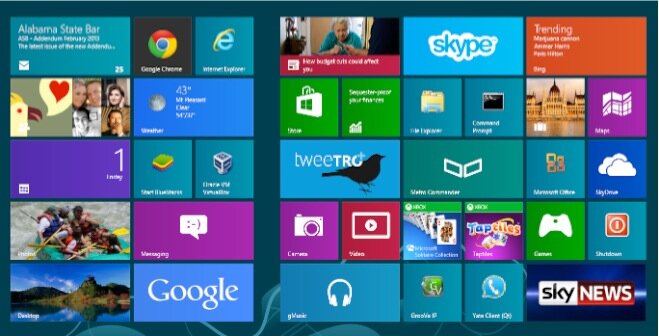
We still needed a good Windows 8 machine on which to test and run our telephony applications. As much as we love our 27″ iMac and MacBook Air, we never like to get too far away from the Microsoft tent especially when Apple is showing signs of returning to their old proprietary ways. Hope springs eternal that the great M$FT comeback is just around the next corner. So what to do?
Portability was a key consideration because we spend considerable time away from home base during the summer. For us, the choice came down to either a good UltraBook or a desktop machine that was easy to move from place to place. As mentioned in our Surface Pro review, the machine also had to be capable of running the BlueStacks Android emulator as well as Oracle’s VirtualBox to host our Linux development platform.
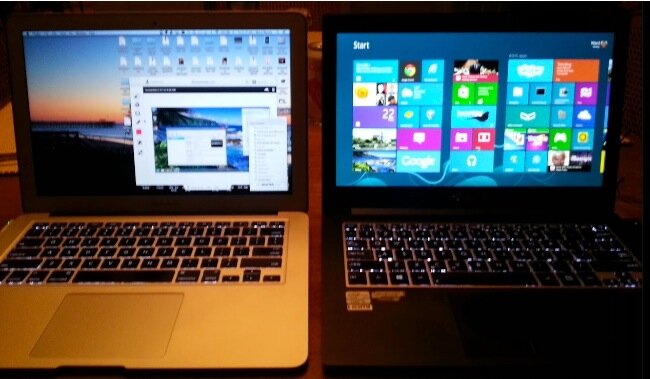
Let’s begin with The Good. For our UltraBook selection, we chose the new Asus Ultrabook UX31A Touch. What a mouthful. The specs were nothing out of the ordinary: 13.3″ Full HD (1920×1080), Intel Core i5 (1.7Ghz) processor, 4GB DDR3 RAM, Intel HD Graphics, WiFi, Bluetooth, and a 128GB SSD with Windows 7 Home Premium. But what a surprise. This machine is a MacBook Air killer. Close your eyes and imagine a MacBook Air with Windows 8 and a touchscreen. Quiet. Excellent performance. Stunning display. Awesome lighted keyboard. Terrific battery life. Ultra lightweight (under 3 pounds). 8 seconds to boot up. And thin (.7″ to be exact). We love this machine. If you’re looking for a portable Windows 8 computer, look no further. Nobody is going to top this one unless the same unit is offered by another retailer with a price tag below Best Buy’s current sale price of $1100.

And Now: The Bad and The Ugly. Sony is the hands-down winner of both awards on the same machine. When you look at the spec sheet, Sony’s new VAIO Tap 20 Mobile Desktop should be the ultimate Dream Machine with its Core i7 processor and 8 gigs of RAM. Add a battery and a semi-portable, but beautiful, 20-inch screen, and it had all the makings of a perfect desktop replacement. And then we turned it on. 45 seconds to boot. A 5400 RPM drive that performs more like a floppy drive when matched against the Asus Ultrabook. "Unbelievably poor performance when loading and running applications" is being kind. For example, taking a screenshot with the Asus Ultrabook is a split-second operation with the image instantly available in the Metro Photos app. Repeating the drill on the Tap 20 took a good 20 seconds for the screenshot to even appear in the Photos collection. We intentionally held off ordering one of these machines until the i7 processor was available because the reviews of the i5 model were so bad. And to think Best Buy actually sells an i3 version of this machine. Hopefully, they leave it on overnight with a large cache enabled.
What’s sad about this is we’ve been a huge fan of Sony products for over 40 years. They always represented best of breed and usually were years ahead of the competition in features. Little wonder that Steve Jobs copied everything he could from Sony when he returned to Apple. Sony made awesome tape recorders including reel-to-reel, 8-track, cassette, and even BetaMax. Their computers and televisions always stood out from the crowd. The Walkman was over 21 years old when the iPod finally hit the market! So what happened?
This machine is a a bit of an embarrassment. 1600×900 resolution on a 20-inch display. Seriously? It means you can’t even watch an HD movie. Putting a 5400 RPM drive in a Core i7 machine is just plain silly. To save five bucks? The computer is so slow that Windows 8 repeatedly locked up just handling trivial tasks. Alerts from Norton routinely popped up warning of impending doom from the poorly performing drive. It’s the only Windows 8 machine that we’ve ever seen hang shutting down when no applications were even running on the desktop. Sorry, Sony, you really blew it. This one’s coming back.
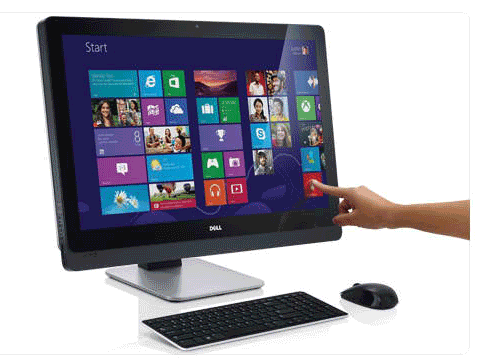
Serenity Now. Just when we had all but given up hope of finding the perfect Windows 8 touchscreen desktop, we decided to forego portability and settle for anything that could truly match the 27″ iMac in performance and features. And, yes, we wanted a great price as well. We’ve always been a big fan of refurbished machines because you know that someone has actually tested the unit to make sure it works. Well, guess what $1,200 will buy? The Dell XPS One 2710T is finally available as an almost half-price, refurbished machine sporting a 3.10 GHz Quad-core i7 processor, 8GB RAM, NVIDIA GeForce GT 640M 2GB GDDR5 Graphics card, 2TB 7200 RPM and DVD+/-RW drives, magnificent 27″ touchscreen display, and a one-year Dell warranty. Add a $50 Crucial m4 32GB mSATA SSD accelerator,1 and you’ve got a gen-u-wine rocketship! It was the well-deserved PCMag Editor’s Choice for 2012. This one’s not going back!
We quickly downloaded our favorite Android VoIP app, Groove IP, from Google’s Play Store using BlueStacks. Then we performed a couple of quick calls using a Google Voice account. The calls were flawless even with our shaky DSL connection on a very snowy day in the mountains. Adding BlueStack’s Cloud Connect will let you push existing apps from your Android phone or tablet to your Windows 8 desktop.
SAMBA connections work fine after the usual tweaks to the Windows Registry and a reboot. NeoRouter as a VPN client or server functions just as you would expect after telling Windows 8 to run the main programs as Administrator. Windows 8 is a bit more picky about this even when you’re logged in as an Administrator. Oracle’s VirtualBox as a virtual machine platform for Linux appliances works swimmingly, and performance is AMAZING. We built an Incredible PBX server using the latest .ova template in under 5 minutes, and we were making free calls and sending out faxes through Google Voice in under 10 minutes.

PBX in a Flash News. If you don’t subscribe to the PBX in a Flash Forum, you probably should. We’ve added a spiffy What’s New Web Portal that will tell you everything you need to know about what’s going on in the Asterisk World. The most important items this week include the release of CentOS 6.4 this past weekend which broke new PBX in a Flash installs briefly. Unlike the other distros, PIAF compiles from source and always gives you the latest updates to CentOS. Sometimes that bites us. But all is well today. The other big news is a major bug in Asterisk 11.2.1 which caused Google Voice to stop working after a period of time until Asterisk was restarted. This has been addressed in Asterisk 11.3 RC1, and we’ll have updates available shortly. In the meantime, you can discover the real beauty of a source-based distribution like PIAF, and upgrade yourself. It’s easy! Here’s how:
amportal stop
cd /usr/src
wget http://downloads.asterisk.org/pub/telephony/asterisk/releases/asterisk-11.3.0-rc1.tar.gz
tar zxvf asterisk-11.3.0-rc1.tar.gz
mv asterisk asterisk-last
mv asterisk-11.3.0-rc1 asterisk
cd asterisk
make clean
./configure
contrib/scripts/get_mp3_source.sh
make menuselect
make
make install
cd ..
cd asterisk-flite
make clean
make
make install
ldconfig
amportal start
echo "Check whether Flite is functioning..."
asterisk -rx "core show application flite"
echo "Check whether CDR reporting is functioning..."
asterisk -rx "module show like mysql"
cd /root
status
The only tricky part is when the menuselect screen appears. Here’s your cheat sheet for the proper settings with PBX in a Flash. Use the cursor keys to move around. Use the Enter key to select/deselect entries. If no section is listed below, leave the default settings. Tab to Save & Exit when you’re finished and press Enter. That’s it.
- Add-ons – Select top 4 entries in –extended–
- Channel Drivers – Deselect chan_gtalk and chan_jingle
- Extra Sound Packages – Select EXTRA-SOUNDS-EN-GSM
Fail2Ban Fails After Midnight. We’re adding this update because of a serious bug discovered on computers running CentOS 6.3 and below. When your logs are automatically rotated, Fail2Ban ceases to function. So, while you’re sleeping like a baby, SO IS Fail2Ban! There’s a simple fix that you’ll find on the PBX in a Flash Forum. Basically, you need to restart Fail2Ban just after your logs are rotated. The bug has been partially addressed in the CentOS 6.4 release.
Originally published: Monday, March 11, 2013 Last Updated: Thursday, March 14, 2013

Need help with Asterisk? Visit the PBX in a Flash Forum.
Special Thanks to Our Generous Sponsors
FULL DISCLOSURE: ClearlyIP, Skyetel, Vitelity, DigitalOcean, Vultr, VoIP.ms, 3CX, Sangoma, TelecomsXchange and VitalPBX have provided financial support to Nerd Vittles and our open source projects through advertising, referral revenue, and/or merchandise. As an Amazon Associate and Best Buy Affiliate, we also earn from qualifying purchases. We’ve chosen these providers not the other way around. Our decisions are based upon their corporate reputation and the quality of their offerings and pricing. Our recommendations regarding technology are reached without regard to financial compensation except in situations in which comparable products at comparable pricing are available from multiple sources. In this limited case, we support our sponsors because our sponsors support us.
 BOGO Bonaza: Enjoy state-of-the-art VoIP service with a $10 credit and half-price SIP service on up to $500 of Skyetel trunking with free number porting when you fund your Skyetel account. No limits on number of simultaneous calls. Quadruple data center redundancy. $25 monthly minimum spend required. Tutorial and sign up details are here.
BOGO Bonaza: Enjoy state-of-the-art VoIP service with a $10 credit and half-price SIP service on up to $500 of Skyetel trunking with free number porting when you fund your Skyetel account. No limits on number of simultaneous calls. Quadruple data center redundancy. $25 monthly minimum spend required. Tutorial and sign up details are here.
 The lynchpin of Incredible PBX 2020 and beyond is ClearlyIP components which bring management of FreePBX modules and SIP phone integration to a level never before available with any other Asterisk distribution. And now you can configure and reconfigure your new Incredible PBX phones from the convenience of the Incredible PBX GUI.
The lynchpin of Incredible PBX 2020 and beyond is ClearlyIP components which bring management of FreePBX modules and SIP phone integration to a level never before available with any other Asterisk distribution. And now you can configure and reconfigure your new Incredible PBX phones from the convenience of the Incredible PBX GUI.
 VitalPBX is perhaps the fastest-growing PBX offering based upon Asterisk with an installed presence in more than 100 countries worldwide. VitalPBX has generously provided a customized White Label version of Incredible PBX tailored for use with all Incredible PBX and VitalPBX custom applications. Follow this link for a free test drive!
VitalPBX is perhaps the fastest-growing PBX offering based upon Asterisk with an installed presence in more than 100 countries worldwide. VitalPBX has generously provided a customized White Label version of Incredible PBX tailored for use with all Incredible PBX and VitalPBX custom applications. Follow this link for a free test drive!
 Special Thanks to Vitelity. Vitelity is now Voyant Communications and has halted new registrations for the time being. Our special thanks to Vitelity for their unwavering financial support over many years and to the many Nerd Vittles readers who continue to enjoy the benefits of their service offerings. We will keep everyone posted on further developments.
Special Thanks to Vitelity. Vitelity is now Voyant Communications and has halted new registrations for the time being. Our special thanks to Vitelity for their unwavering financial support over many years and to the many Nerd Vittles readers who continue to enjoy the benefits of their service offerings. We will keep everyone posted on further developments.
Some Recent Nerd Vittles Articles of Interest…
- There are conflicting reports on how to add an after-market mSATA SSD to the Dell XPS One and get it functioning as a fast cache for your computer. Here’s what worked for us. Lay the computer monitor-side-down on a blanket with the top of the machine facing away from you. With a small Phillips head screwdriver, loosen the two screws on each end of the bottom of the panel, and then slide the back cover towards the top of the machine and remove it. The large metal plate covering the motherboard has to be removed. It’s held in place by 8 screws. Once it’s out of the way, you’ll see two openings for an mSATA card. Gently insert the SSD card in the right one at a 45 degree angle. Then press it down and secure it with the two screws included with the card. Reassemble the computer. Turn it on and press F2 when the Dell logo appears. Go into the Advanced settings, Onboard Device Configuration, SATA Mode. Change the primary drive to RAID. Save your changes with F10 and reboot. When Windows 8 appears, access Control Panel and choose Intel Rapid Storage Technology. Choose the Accelerate option and accept the defaults. Reboot and you’re good to go. [↩]
The 5-Minute PBX: It’s Incredible PBX 11 Virtual Machine for VirtualBox
In our last article, we introduced the PBX in a Flash Virtual Machine for Oracle’s VirtualBox. To commemorate the end of the world today, we wanted to go out with a bang. So we’re pleased to introduce Incredible PBX 11 Virtual Machine. As with the PIAF-Green Virtual Machine, this new appliance features CentOS 6.3, Asterisk® 11, and FreePBX® 2.11 beta. In addition, it includes Incredible Fax with HylaFax and AvantFax, SMS speech-to-text messaging as well as SMS message blasting with Google Voice, and several dozen turnkey Asterisk applications including a speech-to-text phonebook dialer, text-to-speech news, weather, tide, and stock reports, a conference bridge for MeetMe conferencing, NeoRouter and PPTP VPN support, SAMBA for Windows Networking, ODBC database integration, Telephone Reminders and Hotel-Style Wakeup Calls, CallerID Superfecta, PBX End Point Manager, and Wolfram Alpha to name but a few. With the addition of free Google Voice accounts, you still get free voice and fax calling in 2013 throughout the United States and Canada. And, yes, Incredible PBX 11 still installs and is ready to go in under 5 minutes on any Windows, Mac, Linux, or Solaris desktop.

The Ultimate VoIP Appliance: Incredible PBX 11 Virtual Machine for VirtualBox
We broke new ground in the virtual machine development arena last week with the introduction of the PIAF Virtual Machine. Today we take it to the next plateau with a turnkey VoIP appliance that can be deployed and functional in less time than it takes you to shave. Today’s Incredible PBX Virtual Machine still gives you everything a bare metal install from source code would have provided. And, most importantly, the components are truly portable. They can be copied to a 4GB flash drive1 for the price of a good hamburger and installed from there onto any type of machine that happens to be in front of you. Five minutes later, you have a fully functional Asterisk server with FreePBX and exactly the same feature set and source code that you would have had installing Incredible PBX onto a dedicated server. Before you ask any questions, we urge you to try this VoIP appliance for yourself. The install process is as easy as 1-2-3:
- Download and install VirtualBox onto a Desktop Machine of your choice
- Download and double-click on Incredible PBX 11 Virtual Machine to import it into VirtualBox
- Select the Incredible PBX 11 Virtual Machine in VirtualBox Manager Window and click the Start button
Introducing Oracle VM VirtualBox

Here’s a quick review if you missed our last article. VirtualBox®, Oracle’s virtual machine platform inherited from Sun, is really something. It’s not only free, but it’s pure GPL2 code. VirtualBox gives you a virtual machine platform that runs on top of any desktop operating system. In terms of limitations, we haven’t found any. We even tested this on an Atom-based Windows 7 machine with 2GB of RAM, and it worked without a hiccup. So step #1 is to download one or more of the VirtualBox installers from VirtualBox.org or Oracle.com. As mentioned, our recommendation is to put all of the 100MB installers on a 4GB thumb drive. Then you’ll have everything in one place whenever and wherever you happen to need it. Once you’ve downloaded the software, simply install it onto your favorite desktop machine. Accept all of the default settings, and you’ll be good to go. For details, here’s a link to Oracle’s VM VirtualBox User Manual.
Introducing Incredible PBX Virtual Machine
To get Incredible PBX VM installed on your desktop is quick and easy. Because the image tips the scales at over 2GB and due to the 2GB file size limit on many systems, we’ve chosen to split this download into two pieces. You need both of them. Just download them onto any flavor desktop from SourceForge. Once you’ve downloaded the two files, reassemble them into a single file known as an Open Virtualization Appliance (.ova). Then verify the checksums for the reassembled file to be sure everything is in its proper place. Finally, double-click on the .ova file which will initiate the import process into VirtualBox.
So let’s begin by downloading the two halves from SourceForge: INCREDIBLEPBX11aa and INCREDIBLEPBX11ab.
The reassembly procedure depends upon your desktop operating system. For Windows PCs, you’ll need to drop down to the Command Prompt, change to the directory in which you downloaded the two files, and type the following command:
copy /b INCREDIBLEPBX11aa + INCREDIBLEPBX11ab IncrediblePBX11.ova
To check the MD5/SHA1 checksums in Windows, download and run Microsoft’s File Checksum Integrity Verifier.
For Mac or Linux desktops, open a Terminal window, change to the directory in which you downloaded the two files, and type the following commands:
cat INCREDIBLEPBX11a{a..b} > IncrediblePBX11.ova
md5 IncrediblePBX11.ova (use md5sum for Linux)
openssl sha1 IncrediblePBX11.ova
The MD5 checksum for IncrediblePBX11.ova is b17655785ef00381ffd70899a19375f9. The SHA1 checksum is 86ccd31d64d3b51e10a8e7429548be6ce15ecd9b. If you have a match, proceed. Otherwise, rinse and repeat.
Importing Incredible PBX 11 Virtual Machine into VirtualBox
You only perform the import step one time. Once imported into VirtualBox, Incredible PBX is ready to use. There’s no further installation required, just like an OpenVZ template… only better. Double-click on the .ova file you downloaded to begin the procedure and load VirtualBox. When prompted, be sure to check the Reinitialize the Mac address of all network cards box. Read and accept the license agreement. Then click the Import button. Once the import is finished, you’ll see a new IncrediblePBX11 virtual machine in your VM List on the VirtualBox Manager Window. You need to make a couple of one-time adjustments to the IncrediblePBX11 Virtual Machine configuration to account for differences in sound and network cards on different host machines.
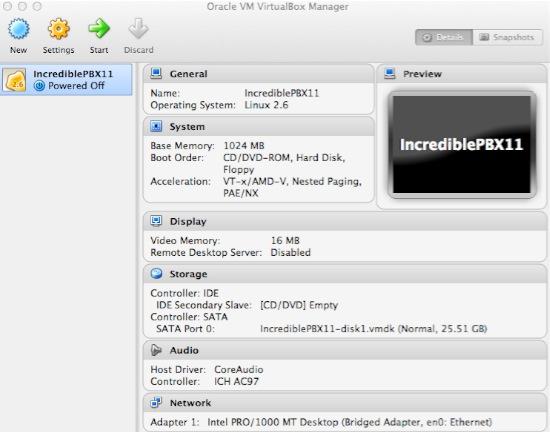
Click on IncrediblePBX11 Virtual Machine in the VM List. Then click Settings -> Audio and check the Enable Audio option and choose your sound card. Save your setup by clicking the OK button. Next click Settings -> Network. For Adapter 1, check the Enable Network Adapter option. From the Attached to pull-down menu, choose Bridged Adapter. Then select your network card from the Name list. Then click OK to save your setup. Finally, click Settings -> System, uncheck Hardware clock in UTC time, and click OK. That’s all the configuration that is necessary for Incredible PBX Virtual Machine. If you blinked, you probably missed it.
Running Incredible PBX Virtual Machine in VirtualBox
Once you’ve imported and configured Incredible PBX Virtual Machine, you’re ready to go. Highlight the appliance in the VM List on the VirtualBox Manager Window and click the Start button. The boot procedure with CentOS 6.3 will begin just as if you had installed PBX in a Flash and Incredible PBX on a standalone machine. You’ll see a couple of dialogue boxes pop up that explain the keystrokes to move back and forth between your host operating system desktop and Incredible PBX.
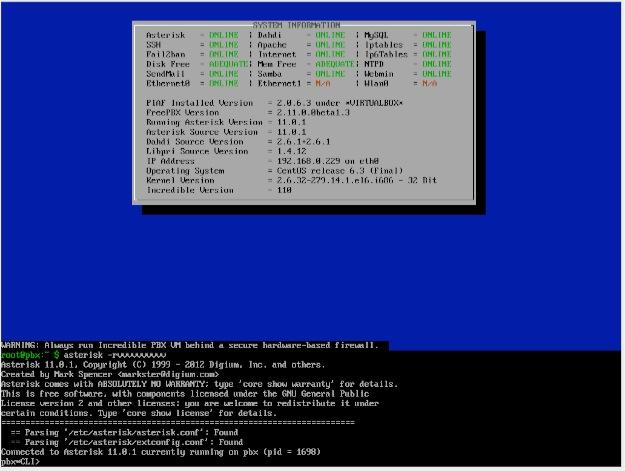
Here’s what you need to know. To work in the Incredible PBX Virtual Machine, just left-click your mouse while it is positioned inside the VM window. To return to your host operating system desktop, press the right Option key on Windows machines or the left Command key on any Mac. For other operating systems, read the dialogue boxes for instructions on moving around. Always shut down Incredible PBX gracefully! Click in the VM window with your mouse, log in as root, and type: shutdown -h now. Or, from the VirtualBox Manager Window, Ctl-Click on the IncrediblePBX11 VM and choose Close -> ACPI Shutdown.
Always run Incredible PBX VM behind a hardware-based firewall with no Internet port exposure!
Linux CLI Setup. To begin, position your mouse over the VM window and left-click. Once the virtual machine has booted, log in as root with password as the password. Change your root password immediately by typing passwd at the command prompt. Now set up a secure maint password for FreePBX as well. Type passwd-master. If you’re not in the Eastern U.S. time zone, then you’ll want to adjust your timezone setting so that reminders and other time-sensitive events happen at the correct time. Issue the following command to pick your time zone: /root/timezone-setup. If you plan to use Incredible Fax to send and receive faxes, set an email address for delivery of incoming faxes: /root/incrediblefax-setup. To use SMS messaging in Incredible PBX, you’ll need a Google Voice account which is covered below. Once you have your credentials, edit extensions_custom.conf in /etc/asterisk and insert your username and password in the 767 extension. To use SAMBA for Windows networking, replace the Interfaces IP address in /etc/samba/smb.conf with your actual IP address. Next, run smbpasswd and assign a password for root access to your server. Then restart SAMBA: service smb restart.
FreePBX Setup. Use a browser to log into your Incredible PBX server by pointing to the IP address of the virtual machine displayed in the status window of the CLI. Click on the User button to display the Admin choices in the Main PIAF Menu. Click on the FreePBX Admin option to load the FreePBX GUI. You will be prompted for a username and password. For the username, use maint. For the password, use whatever password you set up with passwd-master above.
You’ll want to keep FreePBX up to date. The easiest way is to configure FreePBX for email notifications when there are updates. In the FreePBX GUI, choose Admin -> Module Admin -> Upgrade Notifications and plug in your email address. Updates are installed in this same window. Click Check Online -> Upgrade All -> Process and Confirm. Scroll to the bottom of the Status window and click Return. Then click Apply Config. Now you try it.
GOOGLE VOICE ALERT: For old-timers that used the previous Google Voice module in FreePBX 2.x, it’s a little different in FreePBX 2.11. It now is called Google Voice (Motif), and you’ll find it under the Connectivity tab instead of the Other tab. More importantly, the form has changed. Do NOT check all 3 checkboxes as you did previously, or your incoming calls won’t be answered. Leave last checkbox "Send Unanswered to GoogleVoice Voicemail" UNCHECKED!!
Incredible PBX supports SIP, IAX, and Google Voice trunks to handle your outbound and incoming calls. The easiest way to get started it to set up a couple of Google Voice trunks, one for voice calls and one for faxing. These trunks must be dedicated for exclusive use with Incredible PBX. If you’re logged into these Google Voice accounts elsewhere, Incredible PBX won’t receive incoming calls. Read our Incredible PBX Quick Start Guide for the procedure to register for new Google Voice accounts. Once you have your credentials and phone numbers, choose Connectivity -> Google Voice in FreePBX to set up the accounts in FreePBX. For each trunk, you also need to set up an Inbound Route to tell FreePBX how to route the incoming calls. For your Fax trunk, here’s the drill. Choose Connectivity -> Inbound Routes. Insert your 10-digit Google Voice number in the DID Number field. Check Enable CID Superfecta and, for Set Destination, choose Custom Destinations -> Fax (HylaFax). Click Submit and then click Apply Config.
Before your Google Voice trunks will work reliably, there are two final steps. First, restart Asterisk from the Linux CLI: amportal restart. Then, make at least one outbound call using each Google Voice trunk.
We’ve preconfigured SIP trunks for all of the major VoIP providers in Incredible PBX. All you have to do is sign up for a few accounts. This isn’t like the old Ma Bell days so take advantage of the redundancy that using multiple VoIP providers gives you. There’s a very special offer from one of the major sponsors of the PBX in a Flash and Nerd Vittles projects below. Take advantage of it and support our open source projects.
1-7-13 Security Alert: We’ve just released Incredible PBX 11.1.2 which includes Asterisk 11.1.2 and the latest FreePBX 2.11 beta. The Asterisk Dev Team announced a serious security vulnerability in Asterisk 1.8, 10, and 11 late last week. This update addresses that. You can read all about it in the readme file on SourceForge. If you still are using an earlier version of Incredible PBX 11, make certain that it is behind a hardware-based firewall with no Internet port exposure. And you should immediately patch your server or, better yet, switch to this new release.
Now read the latest Incredible PBX Quick Start Guide and begin your VoIP adventure. Then you’ll want to do some reading on VirtualBox. We’ve barely scratched the surface. Setting up Headless VMs that run in the background on any server is a breeze. From the command line, here’s an article to get you started. But you also can start Headless VMs from within the GUI by highlighting the VM and clicking Shift->Start. REMEMBER: Always shut down VMs gracefully: Close->ACPI Shutdown. You’ll find more great tips at virtualbox.org and GitHub.
One of the real beauties of VirtualBox is you don’t have to use a GUI at all. The entire process can be driven from the command line. Other than on a Mac, here is the procedure to import, configure, and run Incredible PBX 11 Virtual Machine:
VBoxManage import IncrediblePBX11.ova
VBoxManage modifyvm "IncrediblePBX11" --nic1 nat
VBoxManage modifyvm "IncrediblePBX11" --acpi on --nic1 bridged
VBoxHeadless --startvm "IncrediblePBX11" &
# Wait 1 minute for IncrediblePBX11 to load. Then decipher IP address like this:
VBoxManage guestproperty get "IncrediblePBX11" /VirtualBox/GuestInfo/Net/0/V4/IP
# Now you can use SSH to login to IncrediblePBX11 at the displayed IP address
# Shutdown the IncrediblePBX11 Virtual Machine with the following command:
VBoxManage controlvm "IncrediblePBX11" acpipowerbutton
On a Mac, everything works the same way except for deciphering the IP address. Download our findip script for that.
Have a very Merry Christmas!
Originally published: Friday, December 21, 2012 Updated: Saturday, December 22, 2012

Need help with Asterisk? Visit the PBX in a Flash Forum.
Special Thanks to Our Generous Sponsors
FULL DISCLOSURE: ClearlyIP, Skyetel, Vitelity, DigitalOcean, Vultr, VoIP.ms, 3CX, Sangoma, TelecomsXchange and VitalPBX have provided financial support to Nerd Vittles and our open source projects through advertising, referral revenue, and/or merchandise. As an Amazon Associate and Best Buy Affiliate, we also earn from qualifying purchases. We’ve chosen these providers not the other way around. Our decisions are based upon their corporate reputation and the quality of their offerings and pricing. Our recommendations regarding technology are reached without regard to financial compensation except in situations in which comparable products at comparable pricing are available from multiple sources. In this limited case, we support our sponsors because our sponsors support us.
 BOGO Bonaza: Enjoy state-of-the-art VoIP service with a $10 credit and half-price SIP service on up to $500 of Skyetel trunking with free number porting when you fund your Skyetel account. No limits on number of simultaneous calls. Quadruple data center redundancy. $25 monthly minimum spend required. Tutorial and sign up details are here.
BOGO Bonaza: Enjoy state-of-the-art VoIP service with a $10 credit and half-price SIP service on up to $500 of Skyetel trunking with free number porting when you fund your Skyetel account. No limits on number of simultaneous calls. Quadruple data center redundancy. $25 monthly minimum spend required. Tutorial and sign up details are here.
 The lynchpin of Incredible PBX 2020 and beyond is ClearlyIP components which bring management of FreePBX modules and SIP phone integration to a level never before available with any other Asterisk distribution. And now you can configure and reconfigure your new Incredible PBX phones from the convenience of the Incredible PBX GUI.
The lynchpin of Incredible PBX 2020 and beyond is ClearlyIP components which bring management of FreePBX modules and SIP phone integration to a level never before available with any other Asterisk distribution. And now you can configure and reconfigure your new Incredible PBX phones from the convenience of the Incredible PBX GUI.
 VitalPBX is perhaps the fastest-growing PBX offering based upon Asterisk with an installed presence in more than 100 countries worldwide. VitalPBX has generously provided a customized White Label version of Incredible PBX tailored for use with all Incredible PBX and VitalPBX custom applications. Follow this link for a free test drive!
VitalPBX is perhaps the fastest-growing PBX offering based upon Asterisk with an installed presence in more than 100 countries worldwide. VitalPBX has generously provided a customized White Label version of Incredible PBX tailored for use with all Incredible PBX and VitalPBX custom applications. Follow this link for a free test drive!
 Special Thanks to Vitelity. Vitelity is now Voyant Communications and has halted new registrations for the time being. Our special thanks to Vitelity for their unwavering financial support over many years and to the many Nerd Vittles readers who continue to enjoy the benefits of their service offerings. We will keep everyone posted on further developments.
Special Thanks to Vitelity. Vitelity is now Voyant Communications and has halted new registrations for the time being. Our special thanks to Vitelity for their unwavering financial support over many years and to the many Nerd Vittles readers who continue to enjoy the benefits of their service offerings. We will keep everyone posted on further developments.
Some Recent Nerd Vittles Articles of Interest…
- Many of our purchase links refer users to Amazon when we find their prices are competitive for the recommended products. Nerd Vittles receives a small referral fee from Amazon to help cover the costs of our blog. We never recommend particular products solely to generate Amazon commissions. However, when pricing is comparable or availability is favorable, we support Amazon because Amazon supports us. [↩]
Time to Celebrate: Incredible PBX for Raspberry Pi Turns 21
 If you had asked us a year ago whether it was possible to run a full-featured PBX on a computer the size of a credit card, we would have laughed and told you to move along. Well, that was then. In the last 21 days, we’ve not only gotten through the proof-of-concept phase of porting Incredible PBX to the Raspberry Pi but, thanks to a lot of hard work from Gernot and his Asterisk® for Raspberry Pi™ project, we now have an incredibly powerful PBX alternative for home and SOHO users with free calling in the U.S. and Canada and a price tag of $50 with the hardware. To celebrate the 21st birthday of Incredible PBX for the Raspberry Pi (that’s days not years), today we introduce two very refined editions of Incredible Pi for both the Debian 6 "Squeeze" and Debian 7 "Wheezy" platforms. For the pioneers, there’s version 2.0 with Wheezy. For those that like stable, we’ve got 1.7 on Squeeze. The feature set is identical. And you can’t beat the price. They’re both FREE!
If you had asked us a year ago whether it was possible to run a full-featured PBX on a computer the size of a credit card, we would have laughed and told you to move along. Well, that was then. In the last 21 days, we’ve not only gotten through the proof-of-concept phase of porting Incredible PBX to the Raspberry Pi but, thanks to a lot of hard work from Gernot and his Asterisk® for Raspberry Pi™ project, we now have an incredibly powerful PBX alternative for home and SOHO users with free calling in the U.S. and Canada and a price tag of $50 with the hardware. To celebrate the 21st birthday of Incredible PBX for the Raspberry Pi (that’s days not years), today we introduce two very refined editions of Incredible Pi for both the Debian 6 "Squeeze" and Debian 7 "Wheezy" platforms. For the pioneers, there’s version 2.0 with Wheezy. For those that like stable, we’ve got 1.7 on Squeeze. The feature set is identical. And you can’t beat the price. They’re both FREE!
Call our Raspberry Pi (1-843-284-6844) and check out the Incredible Pi Smörgåsbord for yourself.
New Incredible Pi Tutorials: 35 Free Incredible PBX Apps for the $35 Raspberry Pi and Version 3.1 Quick Start Guide
We’ve written some very detailed documentation for Incredible Pi, and you can read it at your leisure. Today, we wanted to put together an abbreviated tutorial for those that just want to get a barebones system up and running in about an hour. Most of that time will be consumed copying the Incredible Pi image to an SD card. So there’s plenty of time for lunch during the hour. If you prefer detail, then have at it. For everyone else, keep reading.

What to Buy. Here’s everything you need to get started. The case is optional. Yes, you can run the Raspberry Pi sitting on your desk with no case. It’s only 5 volts. WiFi is also optional. There’s a 10/100 port on the Raspberry Pi that gives you all the networking you need. Here are the links to buy the pieces. You also need a CAT5 cable and either a spare PC or Mac with Putty or SSH and a pair of earbuds or an HDMI cable to connect to a TV or monitor and a USB keyboard.
- $35 Raspberry Pi
- $5 Power Adapter (5V, 1A)
- $10 SanDisk 16GB SDHC Type 4 card
- $15 Adafruit Acrylic Case
- $13 AirLink 101 WiFi Adapter
Setting Up Google Voice. If you want free calling in the U.S. and Canada, then you’ll need a Google Voice account, and you’ll need one dedicated to Incredible Pi, or it won’t work. Log out after setting up the new Google Voice account!
- Register for Google Voice account (no funky characters in your password!)
- Enable Google Chat as Phone Destination
- Configure Google Voice Calls Settings:
- Call Screening – OFF
- Call Presentation – OFF
- Caller ID (In) – Display Caller’s Number
- Caller ID (Out) – Don’t Change Anything
- Do Not Disturb – OFF
- Call Options (Enable Recording) – OFF
- Global Spam Filtering – ON
- Place test call in and out using GMail Call Phone
Baking Your Incredible Pi. The disk drive for the Raspberry Pi is an SD card. So what you need to do is download Incredible Pi and copy the image onto an SDHC card. Mac and Linux installers are included. For Windows, just use Win32 Disk Imager. Here are the steps:
- Download the Incredible Pi package
- Decompress the tarball: tar zxvf incrediblepi-version.tar.gz
- Copy .img file to SDHC using image utility or script
- Insert SDHC card into Raspberry Pi
- Boot the Raspberry Pi from Incredible Pi SDHC card
HINT: While you’re waiting, you can read about all the latest changes and additions to Incredible Pi 2.1 here.
Your First Bite of Incredible Pi. If you’re not using a monitor and will be using SSH to access Incredible Pi, then you need to plug in some earbuds when the bootup process begins. Listen for the Incredible Pi to tell you its IP address when the boot procedure completes. Then login to that IP address with SSH as outlined below.
Here’s everything you need to know about security for Incredible Pi:
1. ALWAYS RUN INCREDIBLE PI BEHIND A SECURE HARDWARE-BASED FIREWALL/ROUTER
2. NEVER EXPOSE ANY INCREDIBLE PI PORTS DIRECTLY TO THE INTERNET
3. NEVER MAP INBOUND INTERNET PORTS FROM YOUR FIREWALL TO INCREDIBLE PI
There also are a few setup steps to complete once your Incredible Pi finishes the bootup process:
- Login to Incredible Pi… username: pi pw: raspberry
- Change password for pi… passwd
- Change password for root… sudo passwd root
- Logout as user pi… logout
- Login as root user… username: root pw:your-new-password
- Set Linux timezone… dpkg-reconfigure tzdata
- Set PHP timezone… nano -w /etc/php5/apache2/php.ini (Ctl-W, Ctl-T, 876)
- Restart web server… service apache2 restart
- Replace SSH keys… rm /etc/ssh/ssh_host_* && dpkg-reconfigure openssh-server
- Set Up WiFi Credentials (optional)… nano -w /etc/wpa.conf
- Set Primary and (optional) Secondary NIC… nano -w /etc/pbx/.nic
- Reboot Your Server… reboot
Accessing Incredible Pi By GUI. You don’t have to be a Linux guru to use Incredible Pi. In fact, we’re just about finished with the Linux command prompt, but stay logged in until we finish the steps below. Most of your configuration of the PBX will be performed using the FreePBX® Web GUI.
If you’re new to Asterisk and FreePBX, here’s the one paragraph primer on what needs to happen before you can make free calls with Google Voice. You’ll obviously need a free Google Voice account. This gets you a phone number for people to call you and a vehicle to place calls to plain old telephones throughout the U.S. and Canada at no cost. You’ll also need a softphone or SIP phone to actually place and receive calls. YATE makes a free softphone for PCs, Macs, and Linux machines so download your favorite and install it on your desktop. Phones connect to extensions in FreePBX to work with Incredible Pi. Extensions talk to trunks (like Google Voice) to make and receive calls. FreePBX uses outbound routes to direct outgoing calls from extensions to trunks, and FreePBX uses inbound routes to route incoming calls from trunks to extensions to make your phones ring. In a nutshell, that’s how a PBX works. There are lots of bells and whistles that you can explore down the road.
Let’s get started. Using a browser, enter the IP address of your server. Choose FreePBX Administration. When prompted for a username and password, use admin for both. Here are the six steps you need to complete before making your first free call:
- Change FreePBX admin Password and Default Email
- Add Google Voice Account credentials
- Set Destination for Incoming Calls
- Change Extension 701 Passwords
- Eliminate Audio and DTMF Problems
- Install and Register a Softphone to Extension 701
1. Changing FreePBX admin Password and Default Email. From the main FreePBX GUI, click Admin => Administrators. Click on admin user in the far-right column. Enter a new Password and click Submit Changes button. Then click the Apply Config button. Next, set your default email address at the bottom of Settings -> General Settings. Repeat the procedure above to save your entry.
2. Activating a Google Voice Trunk. To create a Trunk in FreePBX to handle calls to and from Google Voice, you’ll need three pieces of information from the Google Voice account you set up above: the 10-digit Google Voice phone number, your Google Voice account name, and your Google Voice password. Choose Other -> Google Voice from the FreePBX GUI. The following blank form will appear:

Fill in the blanks with your information and check all 3 boxes. If your Google Voice account name ends in @gmail.com, you can leave that out. Otherwise, include the full email address. Then click Submit Changes and Apply Config.
There’s one more step or your Google Voice account won’t work reliably with Incredible Pi! From the Linux command prompt while logged into your server as root, restart Asterisk: amportal restart
3. Setting a Destination for Incoming Calls. Now that you’ve created your Google Voice Trunk, we need to tell FreePBX how to process inbound calls when someone dials your Google Voice number. There are any number of choices. You could simply ring an extension. Or you could ring multiple extensions by first creating a Ring Group which is just a list of extension numbers. Or you could direct incoming calls to an Interactive Voice Response (IVR) system (we’ve actually set one up for you to play with).
By default, Incredible Pi is configured to route all incoming calls to a demo IVR that shows off some of the applications that come with Incredible Pi. You can change whenever you like by choosing Connectivity -> Inbound Routes -> Default. In the Set Destination section of the form, change the target to Extensions and then select 701 from the list. Then click Submit and Apply Config.
4. Changing Extension Passwords. From the main FreePBX GUI, choose Applications -> Extensions. Then click on 701 in the Extension List on the right side of your display. You’ll see a form that looks like this:

For now, we only need to make a few changes. First, you need a very secure password for both the extension itself and your voicemail account for this extension. The extension secret needs to be a combination of letters and numbers. The Voicemail Password needs to be all numbers, preferably six or more. Replace the existing 1234secret and 1234 with your own (very secure) entries. You also need to lock down this extension so that it is only accessible from devices on your private LAN. You do that with the deny and permit entries which currently are filled with zeroes. Leave the deny entry the way it is which tells Incredible Pi to block everybody except those allowed in the permit entry below. For the permit, we need the first three octets of your private LAN address, e.g. if your LAN is 192.168.0.something then the permit entry will be 192.168.0.0/255.255.255.0.
Finally, you need to plug in your actual email address in the Voicemail section so that voicemails can be delivered to you when someone leaves a message. You can also include a pager email address if you want a text message alert with incoming voicemails. If you want the voicemails to automatically be deleted from the server after they are emailed to you (a good idea considering the disk storage limitations of an SDHC card), change the Delete Voicemail option from No to Yes. That’s it. Now save your settings by clicking the Submit button. Then reload the dialplan by clicking on the red prompt when it appears.
In case you’re curious, unless you’ve chosen to automatically delete voicemails after emailing them, you can retrieve your voicemails by dialing *98701 from any extension on your phone system. You’ll be prompted to enter the voicemail password you set up. In addition to managing your voicemails, you’ll also be given the opportunity to either return the call to the number of the person that called or to transfer the voicemail to another extension’s voicemail box. And you can always leave a voicemail for someone by dialing their extension number preceded by an asterisk, e.g. *701 would let someone leave you a voicemail without actually calling you.
5. Eliminating Audio and DTMF Problems. You can avoid one-way audio on calls and touchtones that don’t work with these simple settings in FreePBX: Settings -> Asterisk SIP Settings. Just plug in your public IP address and your private IP subnet. Then set ULAW as the only Audio Codec.

6. Setting Up a Desktop Softphone. Incredible Pi supports all kinds of telephones, but we’ll start with the easy (free) one today. You can move on to "real phones" once you’re smitten with the VoIP bug. For today, you’ll need to download a softphone to your desktop PC or Mac.
As we mentioned, the easiest way to get started with Incredible Pi is to set up a YATE softphone on your Desktop computer. Versions are available at no cost for Macs, PCs, and Linux machines. Just download the appropriate one and install it from this link. Once installed, it’s a simple matter to plug in your extension 701 credentials and start making calls. Run the application and choose Settings -> Accounts and click the New button. Fill in the blanks using the IP address of Incredible Pi, 701 for your account name, and whatever password you created for the extension. Click OK.

Once you are registered to extension 701, close the Account window. Then click on YATE’s Telephony Tab and place your first call. It’s that easy!

Monitoring Call Progress with Asterisk. That about covers the basics. We’ll leave you with a tip on how to monitor what’s happening with your PBX. There are several good tools within the FreePBX GUI. You’ll find them under the Reports tab. In addition, Asterisk has its own Command Line Interface (CLI) that is accessible from the Linux command prompt. Just execute the following command while logged in as root: asterisk -rvvvvvvvvvv.
Once you’ve done some exploring, take a few minutes to read the more detailed Nerd Vittles tutorials on Incredible Pi and Incredible PBX. We now have a complete tutorial on all 35 Incredible PBX applications that are included in the build. Take a quick look at your convenience. Enjoy!
 Don’t forget to List Yourself in Directory Assistance so everyone can find you by dialing 411. And add your new number to the Do Not Call Registry to block telemarketing calls. Or just call 888-382-1222 from your new number.
Don’t forget to List Yourself in Directory Assistance so everyone can find you by dialing 411. And add your new number to the Do Not Call Registry to block telemarketing calls. Or just call 888-382-1222 from your new number.
Originally published: Tuesday, September 11, 2012
 Support Issues. With any application as sophisticated as this one, you’re bound to have questions. Blog comments are a terrible place to handle support issues although we welcome general comments about our articles and software. If you have particular support issues, we encourage you to get actively involved in the PBX in a Flash Forums. It’s the best Asterisk tech support site in the business, and it’s all free! In fact, there is a thread dedicated to support of Incredible Pi. Please have a look and post your support questions there. Unlike some forums, ours is extremely friendly and is supported by literally hundreds of Asterisk gurus and thousands of ordinary users just like you. You won’t have to wait long for an answer to your question.
Support Issues. With any application as sophisticated as this one, you’re bound to have questions. Blog comments are a terrible place to handle support issues although we welcome general comments about our articles and software. If you have particular support issues, we encourage you to get actively involved in the PBX in a Flash Forums. It’s the best Asterisk tech support site in the business, and it’s all free! In fact, there is a thread dedicated to support of Incredible Pi. Please have a look and post your support questions there. Unlike some forums, ours is extremely friendly and is supported by literally hundreds of Asterisk gurus and thousands of ordinary users just like you. You won’t have to wait long for an answer to your question.
Bug Fixes. A few bugs are to be expected. If you’re using Incredible Pi, please review these on the PIAF Forum at your convenience.

Astricon 2012. Astricon 2012 will be in Atlanta at the Sheraton beginning October 23 through October 25. We hope to see many of you there. We called Atlanta home for over 25 years so we’d love to show you around. Be sure to tug on my sleeve and mention you’d like a free PIAF Thumb Drive. We’ll have a bunch of them to pass out to our loyal supporters. Nerd Vittles readers also can save 20% on your registration by using coupon code: AC12VIT.

Need help with Asterisk? Visit the PBX in a Flash Forum.
whos.amung.us If you’re wondering what your fellow man is reading on Nerd Vittles these days, wonder no more. Visit our new whos.amung.us statistical web site and check out what’s happening. It’s a terrific resource both for us and for you.
Special Thanks to Our Generous Sponsors
FULL DISCLOSURE: ClearlyIP, Skyetel, Vitelity, DigitalOcean, Vultr, VoIP.ms, 3CX, Sangoma, TelecomsXchange and VitalPBX have provided financial support to Nerd Vittles and our open source projects through advertising, referral revenue, and/or merchandise. As an Amazon Associate and Best Buy Affiliate, we also earn from qualifying purchases. We’ve chosen these providers not the other way around. Our decisions are based upon their corporate reputation and the quality of their offerings and pricing. Our recommendations regarding technology are reached without regard to financial compensation except in situations in which comparable products at comparable pricing are available from multiple sources. In this limited case, we support our sponsors because our sponsors support us.
 BOGO Bonaza: Enjoy state-of-the-art VoIP service with a $10 credit and half-price SIP service on up to $500 of Skyetel trunking with free number porting when you fund your Skyetel account. No limits on number of simultaneous calls. Quadruple data center redundancy. $25 monthly minimum spend required. Tutorial and sign up details are here.
BOGO Bonaza: Enjoy state-of-the-art VoIP service with a $10 credit and half-price SIP service on up to $500 of Skyetel trunking with free number porting when you fund your Skyetel account. No limits on number of simultaneous calls. Quadruple data center redundancy. $25 monthly minimum spend required. Tutorial and sign up details are here.
 The lynchpin of Incredible PBX 2020 and beyond is ClearlyIP components which bring management of FreePBX modules and SIP phone integration to a level never before available with any other Asterisk distribution. And now you can configure and reconfigure your new Incredible PBX phones from the convenience of the Incredible PBX GUI.
The lynchpin of Incredible PBX 2020 and beyond is ClearlyIP components which bring management of FreePBX modules and SIP phone integration to a level never before available with any other Asterisk distribution. And now you can configure and reconfigure your new Incredible PBX phones from the convenience of the Incredible PBX GUI.
 VitalPBX is perhaps the fastest-growing PBX offering based upon Asterisk with an installed presence in more than 100 countries worldwide. VitalPBX has generously provided a customized White Label version of Incredible PBX tailored for use with all Incredible PBX and VitalPBX custom applications. Follow this link for a free test drive!
VitalPBX is perhaps the fastest-growing PBX offering based upon Asterisk with an installed presence in more than 100 countries worldwide. VitalPBX has generously provided a customized White Label version of Incredible PBX tailored for use with all Incredible PBX and VitalPBX custom applications. Follow this link for a free test drive!
 Special Thanks to Vitelity. Vitelity is now Voyant Communications and has halted new registrations for the time being. Our special thanks to Vitelity for their unwavering financial support over many years and to the many Nerd Vittles readers who continue to enjoy the benefits of their service offerings. We will keep everyone posted on further developments.
Special Thanks to Vitelity. Vitelity is now Voyant Communications and has halted new registrations for the time being. Our special thanks to Vitelity for their unwavering financial support over many years and to the many Nerd Vittles readers who continue to enjoy the benefits of their service offerings. We will keep everyone posted on further developments.
Some Recent Nerd Vittles Articles of Interest…
R.I.P. Googlicious: Weather, Weather, Everywhere… Except From Google

For at least the last four years, Google has maintained a not-so-secret Weather API that let hobbyists and people like us build weather applications for the rest of the world to use. Google never provided a word of documentation nor even a comment about the Weather API other than obscure mentions by a few Google employees. Google, of course, is not stupid. They know everything there is to know about analytics, and it was no secret that the Weather API had an enormous following worldwide. It was the one and only source of worldwide weather information that didn’t require an API key for access. Most API keys translate into restrictions and monthly fees.
Without a word of warning or comment, Google shut down the Weather API last week. Still no comment a week later despite the howls of righteous indignation from the developer community. Just for the record, this is no way to run a railroad. Of course, Google had no obligation to continue a service that cost them money except for the fact that it earned them enormous goodwill from those around the globe using their service. Earth to Google: these are the same people that have made your company one of the wealthiest in the technology industry! Some have argued that this was a "private service" that was never intended for use by the public. That, of course, is pure horse #2. Google was well aware of the usage by millions of people worldwide. Does anyone think for a moment that Google lacked the necessary skills to secure the Weather API if they had not wanted people to use it? So let’s get real. Like its fruity corporate neighbor, Google loves to introduce "almost secret" technology and rely upon Buzz (remember that one?) to make it a household word. The Weather API was no secret by any stretch.
And there’s another downside, Google. At a time when you’re supposedly encouraging the notion of Cloud Computing, it does the technology little good when you reaffirm how fragile an organization would be if it chose to actually put all its eggs in one basket and rely upon Google infrastructure. What company in its right mind would consider moving to a platform such as Google Apps for Business after observing this sort of corporate behavior? Electing to begin charging for a service is one thing. Phasing out a service after fair notice to those using it was also an option. But blowing a heavily-used service completely out of the water without warning to those relying upon the service is really unacceptable corporate conduct. Makes one wonder what lies just over the horizon with Google Voice, doesn’t it? We’re big fans of Google. But this time around, I’m sorry. Google gets a well-earned D- in our book.

So the question becomes how do we minimize the carnage and put Humpty back together again for those that foolishly relied upon the Nerd Vittles text-to-speech Worldwide Weather app and its underlying Google Weather API. Fortunately for all of us, there are other players in the Weather API marketplace. Here’s a list of 26 of them. One vendor really stands out from the pack. In fact, many believe that Google itself was using its services to power Google’s own weather API. That service is Weather Underground.
What we’ve done is rework the existing Worldwide Weather application in such a way as to minimize the upgrade hassle for those of you already using the broken one. If you’re just getting started, we’ll put all the working pieces in place so there is no patch required. So choose whether to upgrade or install from scratch from the options below, and we’ll have you up and running in a couple minutes.
Regardless of whether you’re just getting started or upgrading, what you will need (that’s new) is a free Weather Underground API key. This lets you issue up to 10 queries a minute and 500 queries a day against Weather Underground’s weather data. Because current conditions and forecasts are separated into separate queries, it means you can actually dial up 5 queries a minute and 250 queries a day without expense. If your needs are more extravagant, Weather Underground has very reasonable rates. Just follow this link to sign up for your Weather Underground API key. Write it down. You’ll need it in a minute.
Upgrading Existing Worldwide Weather App. If you’re currently using Nerd Vittles’ Google News, Weather, Stocks & Dictionary app or Incredible PBX 4, or Incredible Pi, you can upgrade the included Worldwide Weather component by logging into your server as root and issuing the following commands:
cd /var/lib/asterisk/agi-bin
mv nv-weather-google.php nv-weather-google-old.php
wget http://incrediblepbx.com/wunderground.tgz
tar zxvf wunderground.tgz
rm wunderground.tgz
nano -w nv-weather-google.php
nano -w nv-weather-wunderground.php
When the new weather script displays in the nano editor, cursor down to line 21 and replace 12345 with your actual Weather Underground API key. Be sure to preserve the quotes. Then save your change: Ctrl-X, Y, then Enter. That’s it. You’re back in business. Dial 9-4-9 to obtain a spoken weather report for almost any city in the world.
Installing the New Worldwide Weather App. If you’re new to all of this and would like to use either Incredible PBX 4.0 or just the News, Weather, Stocks & Dictionary app, start by reading all about them at the links above. Once you’ve installed either application, log into your server as root and issue the following commands to insert your new API key:
cd /var/lib/asterisk/agi-bin
nano -w nv-weather-google.php
When the new Worldwide Weather script displays in the nano editor, cursor down to line 21 and replace 12345 with your actual Weather Underground API key. Be sure to preserve the quotes. Then save your change: Ctrl-X, Y, then Enter. Now you’re ready to go. Now you can dial 9-4-9 to obtain a spoken weather report for almost any city in the world.
Test Drive. Want to try the new service out for yourself? We’ve set up a Raspberry Pi with Incredible PBX to demonstrate how easy all of this can be with a $35 computer. Just place a call to 1-843-284-6844, choose option 2, and say the name of the city and state or country for an instantaneous Worldwide Weather Report. Enjoy!
Originally published: Tuesday, September 4, 2012

Astricon 2012. Astricon 2012 will be in Atlanta at the Sheraton beginning October 23 through October 25. We hope to see many of you there. We called Atlanta home for over 25 years so we’d love to show you around. Be sure to tug on my sleeve and mention you’d like a free PIAF Thumb Drive. We’ll have a bunch of them to pass out to our loyal supporters. Nerd Vittles readers also can save 20% on your registration by using coupon code: AC12VIT.

Need help with Asterisk? Visit the PBX in a Flash Forum.
Or Try the New, Free PBX in a Flash Conference Bridge.
whos.amung.us If you’re wondering what your fellow man is reading on Nerd Vittles these days, wonder no more. Visit our new whos.amung.us statistical web site and check out what’s happening. It’s a terrific resource both for us and for you.
Special Thanks to Our Generous Sponsors
FULL DISCLOSURE: ClearlyIP, Skyetel, Vitelity, DigitalOcean, Vultr, VoIP.ms, 3CX, Sangoma, TelecomsXchange and VitalPBX have provided financial support to Nerd Vittles and our open source projects through advertising, referral revenue, and/or merchandise. As an Amazon Associate and Best Buy Affiliate, we also earn from qualifying purchases. We’ve chosen these providers not the other way around. Our decisions are based upon their corporate reputation and the quality of their offerings and pricing. Our recommendations regarding technology are reached without regard to financial compensation except in situations in which comparable products at comparable pricing are available from multiple sources. In this limited case, we support our sponsors because our sponsors support us.
 BOGO Bonaza: Enjoy state-of-the-art VoIP service with a $10 credit and half-price SIP service on up to $500 of Skyetel trunking with free number porting when you fund your Skyetel account. No limits on number of simultaneous calls. Quadruple data center redundancy. $25 monthly minimum spend required. Tutorial and sign up details are here.
BOGO Bonaza: Enjoy state-of-the-art VoIP service with a $10 credit and half-price SIP service on up to $500 of Skyetel trunking with free number porting when you fund your Skyetel account. No limits on number of simultaneous calls. Quadruple data center redundancy. $25 monthly minimum spend required. Tutorial and sign up details are here.
 The lynchpin of Incredible PBX 2020 and beyond is ClearlyIP components which bring management of FreePBX modules and SIP phone integration to a level never before available with any other Asterisk distribution. And now you can configure and reconfigure your new Incredible PBX phones from the convenience of the Incredible PBX GUI.
The lynchpin of Incredible PBX 2020 and beyond is ClearlyIP components which bring management of FreePBX modules and SIP phone integration to a level never before available with any other Asterisk distribution. And now you can configure and reconfigure your new Incredible PBX phones from the convenience of the Incredible PBX GUI.
 VitalPBX is perhaps the fastest-growing PBX offering based upon Asterisk with an installed presence in more than 100 countries worldwide. VitalPBX has generously provided a customized White Label version of Incredible PBX tailored for use with all Incredible PBX and VitalPBX custom applications. Follow this link for a free test drive!
VitalPBX is perhaps the fastest-growing PBX offering based upon Asterisk with an installed presence in more than 100 countries worldwide. VitalPBX has generously provided a customized White Label version of Incredible PBX tailored for use with all Incredible PBX and VitalPBX custom applications. Follow this link for a free test drive!
 Special Thanks to Vitelity. Vitelity is now Voyant Communications and has halted new registrations for the time being. Our special thanks to Vitelity for their unwavering financial support over many years and to the many Nerd Vittles readers who continue to enjoy the benefits of their service offerings. We will keep everyone posted on further developments.
Special Thanks to Vitelity. Vitelity is now Voyant Communications and has halted new registrations for the time being. Our special thanks to Vitelity for their unwavering financial support over many years and to the many Nerd Vittles readers who continue to enjoy the benefits of their service offerings. We will keep everyone posted on further developments.
Some Recent Nerd Vittles Articles of Interest…
Introducing Incredible Pi: $35 for Asterisk, FreePBX & Google Voice Utopia

It’s Back-to-School Time in most of the United States, and the Nerd Vittles crew needed a good fall project to distract us from all of this year’s dreadful politicians. We feel like a kid in a candy store with our new $35 Raspberry Pi® Model B. Imagine squeezing a 700 mHz ARM processor with 256MB of RAM, 2 USB ports, a 10/100 Ethernet port,if an HDMI port, composite video, a separate audio jack, an SDHC card slot, and a micro USB port onto a motherboard the size of a credit card with a total weight of 1.6 ounces and a typical power draw of 3.5 watts. Thanks to Gernot and his Asterisk for Raspberry Pi project, a full LAMP stack with Asterisk® and FreePBX® gave us a head start on turning the Raspberry Pi into yet another Incredible PBX™ platform complete with Google Voice™ for free inbound and outbound calling throughout the United States and Canada.
Trust us when we say the performance of this $35 computer is nothing short of amazing. Can it do everything a $200 dual-core Atom PC can do? No. Can it do 90% of everything for someone whose requirements do not exceed a few simultaneous calls at a time but still wants a full-blown PBX for call routing, voicemail, IVRs, music on hold, and text-to-speech and speech-to-text apps for a home, a SOHO office, a Little League team, or a dorm room? Absolutely.
Call our Raspberry Pi at 1-843-284-6844 and check out the Incredible Pi Smörgåsbord for yourself.
Other Incredible Pi Resources: Quick Start Guide for Incredible Pi 3.1 and 35 Free Incredible Pi Apps Tutorial
Incredible PBX for Raspberry Pi: What’s Included
If you’ve never heard of The Incredible PBX, here’s the Top 20 for the Raspberry Pi platform. In addition to the base install with Debian 6, Asterisk 1.8, FreePBX 2.10, Apache, SendMail, MySQL, PHP, and phpMyAdmin, Incredible Pi offers the following built-in PBX components using a wired or wireless network connection:
- AsteriDex
- CallerID Superfecta (FreePBX Module adds Names to CID Numbers)
- CallWho for Asterisk (Dial 4-1-1)
- CDR CallerID Name Support (Inbound Calls)
- Preconfigured Email That Works with SendMail (Email Delivery of Voicemail)
- Extension 701 (A preconfigured extension for your PBX)
- Flite Text-to-Speech (TTS) for Asterisk
- Google Speech-to-Text (STT) for Asterisk
- Google News by Phone (Dial 951)
- Google Stocks by Phone (Dial 950)
- Google Voice (FreePBX Module)
- Hotel-Style Wakeup Calls (Dial *68)
- IVR Demo with 9 Sample Applications (Dial D-E-M-O)
- PPTP VPN Client (preinstalled in 1.5)
- Reminders by Phone and Web (Dial 1-2-3)
- SMS Dictator with Google Voice (Dial S-M-S)
- SMS Message Blasting with Google Voice
- Speech-to-Text Directory Assistance (Dial 411)
- Stealth AutoAttendant
- Time of Day (Dial *61)
- Travelin’ Man 3 (1.2 release only)
- Weather by Zip Code (Dial 947)
- Worldwide Weather by Yahoo (Dial 948)
- Worldwide Weather by Weather Underground (Dial 949)
Ordering Information: What It Takes to Get Started
A complete Incredible PBX build for the Raspberry Pi (Incredible Pi™) is finally finished, and we wanted to give you a head start on ordering the pieces you’ll need to get things going since there is a three to five week delay on some of the components due to huge demand. Nothing is ever just $35, of course. So here’s what you’ll need. The Raspberry Pi itself can be ordered from Newark or MCM. Delivery times and stock vary so check both sites. At the time we ordered, they were quoting 5 weeks. We actually got one from Newark in one week, and as of now MCM has some in stock for immediate shipping. You also need a power adapter. If you have a micro USB power brick for your cellphone, chances are it will work. As long as it’s at least 1 amp and 5 volts, you’re good to go. The recommended 700 mA adapters have reportedly caused issues for some folks so splurge and order a good one. They’re $10 from Amazon while supporting Nerd Vittles.1 If you plan to add the WiFi adapter covered below, you will need at least 1.2 amps to avoid lockups. Next, you’ll need an SDHC card which serves as your hard disk. Be very careful here. The Type 10 cards which arguably would provide the best performance turn out to be a nightmare. Many of them simply don’t work. For a basic system, we’d recommend you start with either the SanDisk 4GB or 16GB SDHC Type 4 card. The 4GB card is available almost everywhere for under $10, or you can order two from Amazon with free Prime shipping for about the same money. If you already have a USB keyboard and a monitor or TV with an available HDMI port or composite video and audio ports, then you’ve got everything you need to get started. Actually, you can do without the monitor and use SSH if you’re either using Incredible Pi 1.3 or if you can decipher the DHCP address of Incredible Pi by reviewing your firewall log. With version 1.3 and beyond, you can plug in a pair of earbuds, and the server will whisper your IP address in your ear after the boot process completes. By the way, you may also want to put your name in the queue for a Pibow case, completely unnecessary but very cute with a long waiting list. It costs almost as much as the computer.

For down the road, suffice it to say, you’re probably not going to want to run Asterisk, FreePBX, and Google Voice on a disk platform of 4 gigabytes although our demo system does exactly that. Between Debian 6.0, Asterisk 1.8, FreePBX 2.10 plus numerous Incredible PBX utilities, well over half of the available 4GB will be consumed by software. For distribution purposes, we’re providing an image that you can write directly to the SDHC card. Unfortunately, the image size determines the amount of space it will actually use on an SDHC card. We will cover below how you can install the 4GB image onto a 16GB card and then expand the size of the main partition to fill the remaining space on the card. But it wouldn’t make sense to distribute a 16GB image because of bandwidth issues. So we’d recommend you purchase a 16GB SanDisk Type 4 SDHC card for production use. Take our advice. Don’t get creative in choosing your SDHC card. Use the one that we’ve already tested and that we know works. If you want to skip the 4GB card completely, that’s perfectly fine, too. The 16GB Type 4 SanDisk card is under $10 from Amazon with free Prime 2-day shipping, or you can pay double and pick one up at your neighborhood Radio Shack store. We’ll also show you how to back up your SDHC card (any size) with your own settings and restore it onto a 16GB card without missing a beat. Unfortunately, once you migrate and expand the main partition on the 16GB card, you’re stuck with that topology. There’s no going back without starting over, and your backups will consume 16GB of storage rather than 4GB. But it sure is convenient… and easy. By the way, here’s a more reasonably priced case and here’s an awesome clear case if you just want something that’s functional.

Finally, you’re going to need an existing Linux server or Mac on which to create your bootable SDHC cards for use with Raspberry Pi. You’ll also need this server to make backups of your existing setup. DD is a wonderful low-level disk copying utility found in Linux, and we’re going to be using it a lot. PBX in a Flash with or without Incredible PBX makes an ideal platform because all of the necessary SDHC disk management utilities already are installed. If you’re not using our recommended Foxconn server, then you’ll need a server with an SDHC card slot, or you can purchase an inexpensive USB-to-SDHC adapter from Amazon for under $2. Without the case, you can build an awesome Asterisk platform for home or SOHO use for under $50, and it can handle 3 simultaneous SIP calls without noticeable degradation.
Here’s a shot of our favorite Incredible Pi setup. You’ll need the LAN cable for the initial boot so that you can SSH into the device to plug in your WiFi SSID name and password. You’ll need the earbuds for the first and second boot to decipher the IP address of the device on your LAN, wired and wireless. No monitor connection is ever required. Just log in with SSH from your Mac or PC. After the first two boots, you can dispense with the CAT5 cable and the earbuds. All of the components are covered in this article.

Creating a Bootable Incredible Pi SDHC Card
SanDisk SDHC Type 4 cards come pre-formatted so all you need to do is insert the card into the SDHC slot of your Asterisk server and reboot it. If you prefer to use a Mac, go here for the tutorial. Before you insert your SDHC card and reboot, log in as root and run the following command: fdisk -l. This will tell you what the existing disk topology of your server is. Write it down. What you don’t want to do is accidentally choose your main Linux drive as the device to copy the Incredible Pi image to, or you end up with a mess. Now insert your SDHC card and reboot your Asterisk server so your SDHC card will be visible. Then run fdisk -l again to decipher the device node of your card. It should be at the bottom of the list and will be something like /dev/sdb. We don’t use /dev/sdb1 in the dd transfer step below, just the base devnode: /dev/sdb or whatever letter your SDHC drive happens to be.
Next, using a web browser, download the latest Incredible Pi image and transfer it to the /root directory of the Linux computer you’ll be using to copy the image to your SDHC card. As we said, we recommend a PBX in a Flash server because it has all of the SDHC utilities already included. Incredible Pi is a free download from SourceForge. The feature sets are described in the SourceForge readme.txt file. Once you’ve copied the desired tarball to your Linux server, decompress it: tar zxvf incrediblepi-1.x.tgz where x is the version you downloaded. Verify the integrity of the image file using md5sum:
1.7: md5sum debian6-incrediblepi-10-09-2012.img => e601ecd890a400de2e03009c034353c2
2.1: md5sum debian7-incrediblepi-16-09-2012.img => 007efb9d2cdf86f054c5cf26c4f5de9a
Finally, run the Linux install script: ./make-sdhc. It takes about 30-60 minutes to copy the image to your SDHC card. If you have a Mac, copy make-sdhc-mac to your Downloads folder and use it.
While you’re waiting, you can read about all the latest changes and additions to Incredible Pi here.
If you’re using our recommended 16GB SanDisk Type 4 SDHC card, then what you have at this juncture is a 16GB card on which only 4GB is being used. Here’s how to expand the main partition to use the other 12GB of space on the card while logged in as root. First, we need to make sure your card’s geometry matches our card setup. From the command prompt, issue the following commands using the proper device node (/dev/sdb) of your card:
parted /dev/sdb
(parted) unit chs
(parted) print
Here’s what you should see:

If the geometry of your card doesn’t match what’s shown above, do NOT use our commands below to adjust your card. Instead, review the original tutorial explaining what needs to be done.
If your geometry matches our geometry above, issue the following commands while still in parted:
move 3 239943,0,0
[press enter to accept default End]
rm 2
mkpart primary 1232,0,0 239942,3,31
print
After entering the above commands, your new card geometry should look like this:

Now type quit. Then complete the resizing by issuing the following commands using your correct device node:
e2fsck -f /dev/sdb2
resize2fs /dev/sdb2
sync
Remove the card from your Linux machine and insert it into the SDHC card slot on the Raspberry Pi.
We’ve also found one 32GB Type 10 card that’s reliable, the Kingston Ultimate X (SD10G2/32gb) which costs about $40 at Amazon. We’ve included the resizing steps below:
fdisk -l
parted /dev/sdb
unit chs
print
move 3 483887,0,0
[press enter to accept End address]
rm 2
mkpart primary 1232,0,0 483886,3,31
print
quit
e2fsck -f /dev/sdb2
resize2fs /dev/sdb2
sync

Preparing the Raspberry Pi for Blastoff
Once the card is in place, there are a few more preliminary steps before you apply power to the device. Plug in a CAT5 LAN cable that is connected to your firewall-protected private network. Make certain that your router is handing out DHCP addresses properly since the Raspberry Pi can’t boot without a network connection to obtain the correct time from an NTP server on the Internet. It has no onboard time clock! Plug in a USB keyboard to one of the two USB ports on the Raspberry Pi. Connect either an HDMI or composite video cable between the Raspberry Pi and a monitor or TV. Finally, plug in a reliable power adapter and insert its micro USB connector into the slot on the Raspberry Pi. You should immediately see a raspberry on your screen with a scrolling list of commands that are executing while the Raspberry Pi is booting. Watch carefully. If you see a bunch of "waiting for hardware interrupt" notices, then you didn’t heed our advice on the type of SDHC card to use. Your card is not compatible for use on the Raspberry Pi so reformat it and use it with your camera. Then go buy the SanDisk card we recommended. The entire boot process should take about 30 seconds. With an incompatible card, that can stretch out to more than an hour. When the boot process completes, the IP address of your Incredible Pi should be displayed with a Linux login prompt. Write down your IP address. You’ll need it in a minute.
Securing Incredible Pi
Congratulations! You’re now ready to begin the Incredible Pi adventure. But, before we get started, first things first. Let’s secure your server. Log in with the username: pi. The password is raspberry. Now change the password to something really secure by issuing the command: passwd. Now do the same thing for the root password of the device: sudo passwd root.
Next, we need to set the default timezone on your machine for both Linux and PHP5. First, switch to the root user account so we don’t have to type sudo before each command: su root. Enter your new root password when prompted. Then run this command to set the default timezone with Debian: dpkg-reconfigure tzdata. For PHP5, you have to manually enter the timezone in the php.ini file: nano -w /etc/php5/apache2/php.ini. Press Ctrl-W to search for timezone. Be sure the line is uncommented and plug in your correct timezone. If you don’t know the magic words to use for your timezone, here’s the list. Save the file: Ctrl-X, Y, and press Enter. Now restart Apache: service apache2 restart.
First, we need to remove the default DUNDI secrets from Asterisk so fresh ones can be automatically generated when you restart Asterisk.
asterisk -rx "database del dundi secret"
asterisk -rx "database del dundi secretexpiry"
amportal restart
Now we need to do the same thing for your SSH keys:
rm /etc/ssh/ssh_host_* && dpkg-reconfigure openssh-server
Now let’s be sure Asterisk is up and running. Then you can continue your adventure using a web browser and the FreePBX GUI. Before we switch, start up the Asterisk CLI: asterisk -rvvvvvvvvvv. Verify that Flite is functioning for TTS: core show application like flite. And make sure the MySQL components are in place to support CDR reporting: module show like mysql. Finally, let’s verify that Jabber is alive and well even though we haven’t set up any Google Voice accounts yet: jabber show connections.
Finally, a few words of warning about security. Incredible Pi is designed to run behind a hardware-based firewall with no Internet exposure to the server itself. Don’t cheat! Prior to the 1.2 release, there are no security mechanisms in place: no IPtables firewall and no Fail2Ban. Beginning with Incredible Pi 1.2, the Linux firewall (iptables) is included, but our recommendation still stands unless you are using the preinstalled Travelin’ Man 3 to enable access of a remote phone connection to your PBX.
All builds do include Suhosin which has been properly configured to facilitate use of phpMyAdmin with MySQL. Within FreePBX, you can secure extensions with strong passwords and IP address filtering, and you need to do that. Exposing Incredible Pi‘s web server to Internet access would be an open invitation to an expensive phone bill. Don’t do it! You’ve been warned.
Securing Incredible Pi with Travelin’ Man 3
Travelin’ Man 3 is a collection of programs that implement firewall whitelists (safe IP addresses) using the Linux firewall, iptables. Before you ever expose your server to any kind of Internet access, read the Nerd Vittles Travelin’ Man 3 article. As delivered with Incredible Pi 1.2 and later, iptables is configured to block all access to your server except from non-routable IP addresses (typically used on LANs sitting behind hardware-based firewalls). The one exception is SIP and IAX access from VoIP Trusted Providers. This allows you to add trunks to your server from these providers without touching your firewall settings.
There are instances in which you may actually need to connect your server from a public Internet site. For example, if you travel for a living and want to use a softphone connected back to your server from a distant hotel room or customer site, you would need access through both your hardware-based firewall and iptables. If one of your children is away at school and needs a free telephone connection, this might also warrant a change in your firewalls. Because of the low cost of a Raspberry Pi, we still believe AND RECOMMEND that you use separate servers to meet remote requirements.
If you still believe remote access is necessary after reading the Travelin’ Man 3 article, then the tools are available by logging into your Incredible Pi server as root and changing to the /root directory. Here are the four apps:

For whiz kids only, Debian manages iptables quite differently than what you may be accustomed to on the CentOS platform. Debian stores iptables rules in /etc/network/iptables. You can reload the iptables rules like this: iptables-restore /etc/network/iptables. And you can display the rules currently in effect like this: iptables-save. Be careful!

Configuring Incredible Pi with FreePBX
Now we’re ready to configure Incredible Pi so that you can start making and receiving calls. We’ll be using the FreePBX web GUI. To begin, using a browser on your desktop, access Incredible Pi by pointing to the IP address of your server (that you wrote down above). Choose FreePBX Administration at the main menu. When prompted for your username and password, enter admin for both.
If you’re new to Asterisk, here’s the one paragraph primer on what needs to happen before you can make free calls with Google Voice. You’ll obviously need a free Google Voice account. This gets you a phone number for people to call you and a vehicle to place calls to plain old telephones throughout the U.S. and Canada at no cost. You’ll also need a softphone or SIP phone to actually place and receive calls. YATE makes a free softphone for PCs, Macs, and Linux machines so download your favorite and install it on your desktop. Phones connect to extensions in FreePBX to work with Incredible Pi. Extensions talk to trunks (like Google Voice) to make and receive calls. FreePBX uses outbound routes to direct outgoing calls from extensions to trunks, and FreePBX uses inbound routes to route incoming calls from trunks to extensions to make your phones ring. In a nutshell, that’s how a PBX works. There are lots of bells and whistles that we will cover later.
Before you do anything else, change your admin password to access FreePBX. From the main FreePBX GUI, choose Admin => Administrators. Next, set your default email address at the bottom of Settings -> General Settings.
So here’s our 7-Step Checklist to set things up. After you complete these steps, you can start making free calls throughout the U.S. and Canada. And people can call you using your new Google Voice number.
1. Create a free Google Voice account
2. Set up Extension to connect to softphone
3. Create a Google Voice Trunk using GV credentials
4. Create an Inbound Route from Google Voice to Extension
5. Create an Outbound Route from Extension to Google Voice
6. Download and Configure YATE softphone
7. Make Your First Call
Creating a Free Google Voice Account
You’ll need a dedicated Google Voice account to support Incredible Pi. The more obscure the username (with some embedded numbers), the better off you will be. This will keep folks from bombarding you with unsolicited Gtalk chat messages, and who knows what nefarious scheme will be discovered using Google messaging six months from now. So keep this account a secret!
We’ve tested this extensively using an existing Gmail account, and inbound calling is just not reliable. The reason seems to be that Google always chooses Gmail chat as the inbound call destination if there are multiple registrations from the same IP address. So, be reasonable. Do it our way! Set up a dedicated Gmail and Google Voice account, and use it exclusively with Incredible Pi. Google Voice no longer is by invitation only so, if you’re in the U.S. or have a friend that is, head over to the Google Voice site and register. Don’t use funky characters in your Google password! If you’re living on another continent, see MisterQ’s posting for some setup tips.
You must choose a telephone number (aka DID) for your new account, or Google Voice calling will not work… in either direction. Google used to permit outbound Gtalk calls using a fake CallerID, but that obviously led to abuse so it’s over! You also have to tie your Google Voice account to at least one working phone number as part of the initial setup process. Your cellphone number will work just fine. Don’t skip this step either. Just enter the provided 2-digit confirmation code when you tell Google to place the test call to the phone number you entered. Once the number is registered, you can disable it if you’d like in Settings, Voice Setting, Phones. But…
IMPORTANT: Be sure to enable the Google Chat option as one of your phone destinations in Settings, Voice Setting, Phones. That’s the destination we need for Incredible Pi to work its magic! Otherwise, all inbound and outbound calls will fail. If you don’t see this option, you may need to call up Gmail and enable Google Chat there first. Then go back to the Google Voice Settings.
While you’re still in Google Voice Settings, click on the Calls tab. Make sure your settings match these:
- Call Screening – OFF
- Call Presentation – OFF
- Caller ID (In) – Display Caller’s Number
- Caller ID (Out) – Don’t Change Anything
- Do Not Disturb – OFF
- Call Options (Enable Recording) – OFF
- Global Spam Filtering – ON
Click Save Changes once you adjust your settings. Under the Voicemail tab, plug in your email address so you get notified of new voicemails. Down the road, receipt of a Google Voice voicemail will be a big hint that something has come unglued with Incredible Pi.
Configuring an Extension to Use with a SIP Phone
As mentioned, an Extension is the component in FreePBX that actually interfaces with a telephone. Whether to use a hardware-based phone or a softphone is your choice. Without an adapter, POTS phones won’t work with Incredible Pi. You’ll need a SIP phone. We’ll set up a softphone today to get you started, but first we need to configure an extension in FreePBX. We’ve actually made one for you to use, extension 701. So, rather than create a new one, let’s just modify the one that’s already in place. You can add additional extensions later to support additional phones.
From the main FreePBX GUI, choose Applications -> Extensions. Then click on 701 in the Extension List on the right side of your display. You’ll see a form that looks like this:

For now, we only need to make a few changes. First, you need a very secure password for both the extension itself and your voicemail account for this extension. The extension secret needs to be a combination of letters and numbers. The Voicemail Password needs to be all numbers, preferably six or more. Replace the existing 1234secret and 1234 with your own (very secure) entries. You also need to lock down this extension so that it is only accessible from devices on your private LAN. You do that with the deny and permit entries which currently are filled with zeroes. Leave the deny entry the way it is which tells Incredible Pi to block everybody except those allowed in the permit entry below. For the permit, we need the first three octets of your private LAN address, e.g. if your LAN is 192.168.0.something then the permit entry will be 192.168.0.0/255.255.255.0.
Finally, you need to plug in your actual email address in the Voicemail section so that voicemails can be delivered to you when someone leaves a message. You can also include a pager email address if you want a text message alert with incoming voicemails. If you want the voicemails to automatically be deleted from the server after they are emailed to you (a good idea considering the disk storage limitations of an SDHC card), change the Delete Voicemail option from No to Yes. That’s it. Now save your settings by clicking the Submit button. Then reload the dialplan by clicking on the red prompt when it appears.
In case you’re curious, unless you’ve chosen to automatically delete voicemails after emailing them, you can retrieve your voicemails by dialing *98701 from any extension on your phone system. You’ll be prompted to enter the voicemail password you set up. In addition to managing your voicemails, you’ll also be given the opportunity to either return the call to the number of the person that called or to transfer the voicemail to another extension’s voicemail box. And you can always leave a voicemail for someone by dialing their extension number preceded by an asterisk, e.g. *701 would let someone leave you a voicemail without actually calling you.
Activating a Google Voice Trunk in FreePBX
To create a Trunk in FreePBX to handle calls to and from Google Voice, you’ll need three pieces of information for the Google Voice account you set up above: the 10-digit Google Voice phone number, your Google Voice account name, and your Google Voice password. Once you have these in hand, choose Other -> Google Voice from the FreePBX GUI. The following blank form will appear:

Fill in the blanks with your information and check all 3 boxes. If your Google Voice account name ends in @gmail.com, you can leave that out. Otherwise, include the full email address. Then click Submit Changes and reload your dialplan when prompted.
There’s one more step or your Google Voice account won’t work reliably with Incredible Pi! From the Linux command prompt while logged into your server as root, restart Asterisk: amportal restart
Creating an Inbound Route for Your Google Voice Trunk
Now that you’ve created your Google Voice Trunk, we need to tell FreePBX how to process the call when someone dials your Google Voice number. There are any number of choices. You could simply ring an extension. Or you could ring multiple extensions by first creating a Ring Group which is just a list of extension numbers. Or you could direct incoming calls to an Interactive Voice Response (IVR) system (we’ve actually set one up for you to play with). For the time being and since you only have one extension at the moment, let’s just route incoming Google Voice calls to extension 701.
To do this, you create an Inbound Route based upon the DID (phone number) of the Google Voice trunk. In FreePBX, choose Connectivity -> Inbound Routes. Fill in the form so that it looks like the example below using your own 10-digit Google Voice description and number instead of Atlanta GV and 6781234567. Be sure to set the Destination.

Then click Submit. But, before you reload the dialplan, make one change to the form. Click on the CID Lookup Source pull-down menu and choose CallerID Superfecta. This tells FreePBX to actually add names to phone numbers when someone calls. Now click Submit again and reload the dialplan when prompted.
Creating an Outbound Route for Google Voice Calls
FreePBX is actually smart enough to create an outbound route for your new Google Voice trunk so that you can place calls from any extension by dialing either a 10-digit number or 1 plus a 10-digit number to call anyone in the U.S. or Canada. If that’s all you care about, you can skip to the next section. But there’s more.
You can have more than one Google Voice trunk with Incredible Pi, and each one could be in a different area code. For example, you may do business in many different places and would like a local number for folks to call. Or Grandma may live in a distant city, and you’d like her to be able to call you without paying long distance charges. Then there are the kids. If you have three, you might want to give each of them their own Google Voice number which would ring just their phone. And, for outbound calls, you’d like each of them to use their own Google Voice trunk. All of these options are possible with Incredible Pi.
For outbound calls with multiple Google Voice trunks, you need a way to tell the system which trunk to use. We recommend dial prefixes that identify the city of the trunk, e.g. ATL, NYC, MIA. Or, for the kids, a dial prefix made up of initials, e.g. KHM, RWM, JSM. These dial prefixes get stripped off before the call is actually placed so the prefix is only used to determine the trunk used for placing the call.
To implement dial prefixes, you’ll need to adjust the default entries for your Google Voice Outbound Routes by adding the prefix option as an additional Dial Pattern. Here’s an example using an Atlanta Google Voice trunk where we want to allow a prefix of ATL-XXX-XXX-XXXX to force a call to go out on the Atlanta Google Voice trunk:

Another option may be appealing if you happen to make a lot of international calls and don’t want to pay for them. First, you can read all about iNum calling in this Nerd Vittles article. Another hidden feature in Google Voice is the ability to place iNum calls worldwide at no cost. To implement this, you’ll need to add another Dial Pattern to your Google Voice trunk. Prepend: 8835100 with Match Pattern: XXXXXXXX. Now you can dial iNum DIDs by dialing just the last 8 digits using any phone on your server. For example, try out the Nerd Vittles’ Dictionary Demo by calling 09901997. There also are a huge number of iNum Access Numbers that will let you call back to your server or any other iNum DID from almost anywhere in the world at no cost. These are covered in the Nerd Vittles article as well.
Configuring a YATE Softphone
As we mentioned, the easiest way to get started with Incredible Pi is to set up a YATE softphone on your Desktop computer. Versions are available at no cost for Macs, PCs, and Linux machines. Just download the appropriate one and install it from this link. Once installed, it’s a simple matter to plug in your extension 701 credentials and start making calls. Run the application and choose Settings -> Accounts and click the New button. Fill in the blanks using the IP address of Incredible Pi, 701 for your account name, and whatever password you created for the extension. Click OK.

Once you are registered to extension 701, close the Account window. Then click on YATE’s Telephony Tab and place your first call. It’s that easy!

Configuring Email Messaging
Incredible Pi comes preconfigured with SendMail to provide reliable delivery of outbound email messages. You can test it by logging in and issuing the following command using your own email address instead of yourname@gmail.com:
echo "test" | mail -s testmessage yourname@gmail.com
If you don’t receive the message, chances are that your Internet Service Provider blocks downstream mail servers from sending email to reduce spam. To fix it, the simplest way is to configure SendMail to use your ISP as the smart relay host for outbound mail, e.g. with Comcast, it’s smtp.comcast.net. It takes about 10 seconds to configure. After logging in as root, edit /etc/mail/sendmail.cf. Change line 116 from DS to DSsmtp.comcast.net using the SMTP gateway domain of your ISP. Save your change and restart SendMail: service sendmail restart. Then send another test message to make sure it works. If that fails, you can use Gmail as the mail relay. Here’s how. Now voicemail messages delivered directly to any email account by inserting your email address in the Voicemail section of the extension accepting your voicemail messages.
Configuring SMS Messaging
Incredible Pi also allows you to dictate messages and deliver them to any phone which accepts SMS messages. Just dial S-M-S (767) from any extension on your server. In addition, you can use Incredible Pi’s Message Blaster to send SMS messages to a group of individuals, e.g. a Little League team. In order to use SMS messaging, you must have at least one Google Voice account configured on your server. Then it’s a simple matter of inserting your Google Voice account name and password in two files. First, edit extensions_custom.conf in /etc/asterisk. On the second line of the 767 extension, replace acctname with your Google Voice account name (without @gmail.com). On the third line, replace acctpass with your Google Voice password for this account. Reload your dialplan to activate the new settings:
asterisk -rx "dialplan reload"
For the message blasting service, change to the /root directory. Insert the numbers to be dialed in the smslist.txt file following the example in the file. Enter the SMS message to be sent in smsmsg.txt keeping in mind that many phone providers limit SMS messages to 140 characters or less. Finally, insert your Google Voice account name (with @gmail.com) and password in smsblast. To kick off an SMS message blast, just issue the command: ./smsblast.
Configuring SAMBA for Windows Networking Support
Beginning with Incredible Pi 1.4, SAMBA is included in the distribution for transparent access using the Windows Networking Protocol from PCs, Macs, and other Linux machines. As delivered, SAMBA is deactivated. For obvious reasons, we recommend you never activate root login access to SAMBA. If you wish to enable SAMBA on your server, here are the steps while logged in as root:
- 1. Set SAMBA password for user pi: smbpasswd -a pi
- 2. Change Windows workgroup from WORKGROUP, if needed: nano -w /etc/samba/smb.conf
- 3. Manually start SAMBA from command prompt: service samba start
- 4. Set SAMBA to start on boot: rcconf and activate SAMBA option with space bar
- 5. reboot
A Word of Warning: We’ve apparently reached the end of Memory Lane with SAMBA. Only activate it permanently (#4) after thoroughly testing it (#3) in your environment. We have found TTS IVRs in particular to be less than stable with SAMBA running.
Troubleshooting Audio Problems with Phone Calls
For most good routers/firewalls, there should be no problems connecting calls with Google Voice or SIP calls inbound or outbound. If you place a call and the audio is missing in one or both directions or your end of the call continues to ring even after the other person has answered, these are telltale signs of NAT and RTP connection issues. The quick fix is to plug in your public IP address and private LAN information under Settings -> Asterisk SIP Settings -> NAT Settings in FreePBX. If you continue to have connectivity issues, post the symptoms of your problem on the PIAF Forum and one of our helpful gurus will offer additional suggestions. Be sure to include the make and model of your router/firewall.
Using AsteriDex
Incredible Pi includes a robust phonebook application that uses MySQL for storage. You can access it with a browser by pointing to the following link using the IP address of your own server: http://192.168.0.185/asteridex4. Some entries for your favorite airlines are included to get you started. You can add, change, and delete entries under the Admin panel.

By dialing 411 from any phone on your system, you can speak the name of any entry in your AsteriDex database, and Incredible Pi will look up the name and dial the number. Try American Airlines just for fun.
Managing CallerID Superfecta
What began with our first release of CallerID Trifecta many years ago now has grown into one of the best examples of collaborative computing in the open source community. Maintained by the PBX Open Source Software Alliance, CallerID Superfecta now performs a number of functions in addition to matching names against phone numbers. Today you can display incoming call alerts and pop-ups on all sorts of devices in your home or office including XBMC, SqueezeBox, Winunciator, and many more. You can tailor CallerID Superfecta to meet your own local needs by opening the Default Superfecta tab under Other -> CallerID Superfecta in FreePBX. As with all database lookups, they take time. So keep in mind that you are trying to find the best match for inbound calls that takes the least time to retrieve corresponding CNAM information for the caller. To facilitate your search for the perfect combination, CallerID Superfecta includes a testing facility which will report the time required for each lookup. Then you can sort your lookup sources accordingly. To follow the latest developments, visit this thread on the PIAF Forums.
Adding Wireless Network Support
Particularly with a device the size of the Raspberry Pi, you may find it more convenient to place the unit on a bookshelf where a wired network connection is not feasible. This setup already is included in Incredible Pi 1.1 and later. For those using the 1.0 release, here’s how to use your Raspberry Pi wirelessly. First, order a TP-Link TL-WN722N USB 802.11n WiFi Adapter from Amazon for under $20. You won’t need a USB extender cable. This device can easily be plugged into one of the two USB slots without jeopardizing your ability to also connect a USB keyboard. Be sure your 5V power adapter is rated at 1.2 amps or greater to avoid lockups!2
We recommend the 1.3 Incredible Pi release or later if you plan to go the wireless route. All of the wireless networking components already are in place. Log into Incredible Pi as root (or su root for purists) and edit /etc/wpa.conf. Insert the SSID name and password for your wireless access point. Then reboot your server and wireless networking "just works."

Beginning with the 1.3 release, support has been added for the ultra-tiny AirLink 101 Wireless N adapter (AWLL5088). The setup process is identical to the 1.1 setup above. Just edit /etc/wpa.conf and insert the SSID name and password for your wireless access point. We strongly recommend disabling network connections that you aren’t using, e.g. eth0 and wlan0 if you go the AirLink 101 route. Just edit /etc/network/interfaces and comment out the eth0 line as well as the block of commands pertaining to wlan0. Then reboot, a process that now will be much quicker. If you plug in earbuds when you reboot, Incredible Pi 1.3 or later will read you the DHCP-assigned IP address when the boot process finishes so you no longer need a monitor. SSH can be used to connect to your server from any desktop PC or Mac.
Adding a PPTP VPN Client to Incredible Pi
If you’ve followed the Nerd Vittles tutorial and previously set up a PPTP VPN Server for your devices, then it’s pretty simple to add Incredible Pi to the mix by activating a PPTP VPN client. It’s only a few steps. You’ll need the FQDN or public IP address of your VPN server as well as a username and password for VPN access to your VPN server. Once you have those in hand, log into Incredible Pi as root.
Lest we forget to mention, you cannot log into your PPTP server from an IP address on the same private LAN so you’ll need to take your Incredible Pi device to a neighbor’s house to test this.
If you’re using Incredible Pi 1.5 or later, all of the PPTP VPN client software already is in place. Edit the connection template: nano -w /etc/ppp/peers/my-pptp-server. Insert the following text and replace myfqdn.org with the FQDN of your PPTP server, replace myname with your PPTP username, and replace mypassword with your PPTP password. Then save the file: Ctrl-X, Y, then Enter.
Now activate the PPTP VPN client. On your Incredible Pi server, run rcconf. If you’re using a release prior to 1.4, you’ll need to install rcconf first with the command: apt-get install rcconf. Scroll to the bottom of the list until you’ve highlighted pptp. Press the space bar to select it for automatic startup when you boot your server. Then tab to OK and press Enter.
To test it, issue the following command: /etc/init.d/pptp start. When you run ifconfig, you should now see a ppp0 entry:
ppp0 Link encap:Point-to-Point Protocol
UP POINTOPOINT RUNNING NOARP MULTICAST MTU:1500 Metric:1
RX packets:0 errors:0 dropped:0 overruns:0 frame:0
TX packets:0 errors:0 dropped:0 overruns:0 carrier:0
collisions:0 txqueuelen:3
RX bytes:0 (0.0 B) TX bytes:0 (0.0 B)
Remember, it won’t show an IP address if the Raspberry Pi and your PPTP VPN Server are on the same subnet (like ours). Once you install your Raspberry Pi in a remote location, you now can access it at the first IP address in your reserved PPTP IP address pool.
Power Adapters: The Hidden Gotcha
We’ve learned a lot about power adapters since acquiring the Raspberry Pi. First, not all adapters are created equal. Second, the type adapter you require depends upon what you’ve plugged into those USB ports. If one of the residents is a WiFi adapter, then the power draw of the WiFi adapter can add an additional wrinkle.
Here’s what we’ve found. If you decide to use the TP-Link TL-WN722N adapter, you’ll need a power adapter rated for at least 5V, 1.2 amps. These are few and far between and many adapters rated at even higher amperages (and not U/L approved) still won’t keep your RasPi from crashing regularly. We have had good results with $9.99 RND Power Solutions 2.1A Dual USB AC Adapter so long as you use the USB port closest to the red light and leave the second USB unoccupied.
If you use the AirLink 101 WiFi adapter or no WiFi adapter, then a less expensive 5V, 1A adapter may suffice. They’re typically about half the price, but some users have reported issues. For testing results and details, see this thread.
We’ve tested these adapters, and they both work. We can also count on both hands the number of adapters we tested that fail to keep the Raspberry Pi functioning. If you have a 1.2+ amp adapter from a reputable tablet computer, that will probably work as well. These replacement adapters tend to cost $25 or more. So the choice is yours. If your Raspberry Pi experiences frequent lockups, then an underperforming power adapter is the likely culprit, not the Raspberry Pi itself.
VoIP Redundancy: Use It to Your Advantage
As much as we love Google Voice, things do go wrong from time to time. The real beauty of VoIP telephony is there’s absolutely no reason to put all of your eggs in one basket. Multiple providers don’t cost you much particularly if you don’t use them regularly. And, when things go wrong, you won’t have to scramble to continue making phone calls. Vitelity has been a generous, long-term supporter of Nerd Vittles and our projects. You’ll find a compelling offer below, and we encourage you to consider them. Here’s the Incredible PBX Top 20 Trunk List with some reasons why these providers made our short list:
- AxVoice ($14.99/mo. Business Plan; $16.58/mo. Unlimited Calls to 45 Countries)
- CallCentric (Good International Calling Rates; Free iNum DID)
- DIDforSale (20 channels per DID; unlimited DID calls for $8.99/mo.)
- ENUM
- FlowRoute (Good International Calling Rates)
- FreeNum
- Future-Nine (Supports CallerID Spoofing)
- Google Voice (Free DIDs and free U.S./Canada calling)
- IPkall (Free SIP/IAX DIDs)
- Les.net (Supports CallerID Spoofing; very low rates)
- LocalPhone (Dirt-cheap DIDs and calling rates worldwide; Free iNum DID)
- Simon Telephonics (Free SIP-to-GoogleVoice Gateway)
- SIPgate (Free residential DIDs sometimes)
- Skype (Free Skype-to-Skype calls worldwide)
- Teliax (Unlimited inbound DID $5/mo.)
- Vitelity (Our supporter and the Best in the Business!)
- VoIPms (CallerID spoofing; Free iNum calling; Very low rates)
- VoIPMyWay (Residential Unlimited: $15.50/mo. Business Unlimited: $40/mo.)
- VoIPStreet (Free DID)
Making Backups of Incredible Pi
Last, but not least, you’ll need to make periodic backups of your Incredible Pi system unless you don’t mind starting over when disaster strikes. It’s easy using almost any Linux server, and it’s especially easy with a PBX in a Flash server.
To begin, shutdown your Incredible Pi server gracefully: sudo shutdown -h now. Once the display shows that the system has halted, unplug it and remove the SDHC card. Then insert the SDHC card into the slot or reader on your PIAF system and reboot the server. Log into your server as root and issue the fdisk -l command to decipher the devname of your SDHC disk, e.g. /dev/sdb. To make a backup of your SDHC card, issue the following commands using today’s date and the proper devname for your SDHC drive:
dd if=/dev/sdb of=/root/incrediblepi-08-20-2012.img
sync
gzip /root/incrediblepi-08-20-2012.img
When the process is finished, you’ll have a compressed image roughly one-third the size of your SDHC card.
Firmware and Kernel Updates
Only after making a backup, you may find it helpful to upgrade your Raspberry Pi firmware and kernel from time to time. Releases of Incredible Pi below 1.4 do not have the firmware updating tool in place. So you’ll first have to install it. Log into your server as root and issue these commands:
wget http://goo.gl/1BOfJ -O /usr/bin/rpi-update
chmod +x /usr/bin/rpi-update
You can decipher the kernel currently running on your Raspberry Pi by issuing the command: uname -a
To determine GPU’s firmware version, issue the command: /opt/vc/bin/vcgencmd version
Once the updater has been installed (and after you’ve made a backup!), you can update your Raspberry Pi’s kernel and firmware to the latest and greatest by issuing the following commands while logged in as root. The latest kernel addresses some issues with the USB ports and is worth installing: raspberrypi 3.2.27+ #66 PREEMPT Fri Aug 24 with GPU firmware version 332937.
rpi-update
reboot
 Don’t forget to List Yourself in Directory Assistance so everyone can find you by dialing 411. And add your new number to the Do Not Call Registry to block telemarketing calls. Or just call 888-382-1222 from your new number.
Don’t forget to List Yourself in Directory Assistance so everyone can find you by dialing 411. And add your new number to the Do Not Call Registry to block telemarketing calls. Or just call 888-382-1222 from your new number.
Originally published: Monday, August 20, 2012
Continue Reading… Incredible PBX for Raspberry Pi Turns 21
 Support Issues. With any application as sophisticated as this one, you’re bound to have questions. Blog comments are a terrible place to handle support issues although we welcome general comments about our articles and software. If you have particular support issues, we encourage you to get actively involved in the PBX in a Flash Forums. It’s the best Asterisk tech support site in the business, and it’s all free! In fact, there is a thread dedicated to support of Incredible Pi. Please have a look and post your support questions there. Unlike some forums, ours is extremely friendly and is supported by literally hundreds of Asterisk gurus and thousands of ordinary users just like you. You won’t have to wait long for an answer to your question.
Support Issues. With any application as sophisticated as this one, you’re bound to have questions. Blog comments are a terrible place to handle support issues although we welcome general comments about our articles and software. If you have particular support issues, we encourage you to get actively involved in the PBX in a Flash Forums. It’s the best Asterisk tech support site in the business, and it’s all free! In fact, there is a thread dedicated to support of Incredible Pi. Please have a look and post your support questions there. Unlike some forums, ours is extremely friendly and is supported by literally hundreds of Asterisk gurus and thousands of ordinary users just like you. You won’t have to wait long for an answer to your question.
Bug Fixes. A few bugs are to be expected. If you’re using Incredible Pi, please review these on the PIAF Forum. A serious problem with IPtables has now been fixed in Incredible Pi 1.5. A patch for previous versions is on the forum.

Astricon 2012. Astricon 2012 will be in Atlanta at the Sheraton beginning October 23 through October 25. We hope to see many of you there. We called Atlanta home for over 25 years so we’d love to show you around. Be sure to tug on my sleeve and mention you’d like a free PIAF Thumb Drive. We’ll have a bunch of them to pass out to our loyal supporters. Nerd Vittles readers also can save 20% on your registration by using coupon code: AC12VIT.

Need help with Asterisk? Visit the PBX in a Flash Forum.
whos.amung.us If you’re wondering what your fellow man is reading on Nerd Vittles these days, wonder no more. Visit our new whos.amung.us statistical web site and check out what’s happening. It’s a terrific resource both for us and for you.
Special Thanks to Our Generous Sponsors
FULL DISCLOSURE: ClearlyIP, Skyetel, Vitelity, DigitalOcean, Vultr, VoIP.ms, 3CX, Sangoma, TelecomsXchange and VitalPBX have provided financial support to Nerd Vittles and our open source projects through advertising, referral revenue, and/or merchandise. As an Amazon Associate and Best Buy Affiliate, we also earn from qualifying purchases. We’ve chosen these providers not the other way around. Our decisions are based upon their corporate reputation and the quality of their offerings and pricing. Our recommendations regarding technology are reached without regard to financial compensation except in situations in which comparable products at comparable pricing are available from multiple sources. In this limited case, we support our sponsors because our sponsors support us.
 BOGO Bonaza: Enjoy state-of-the-art VoIP service with a $10 credit and half-price SIP service on up to $500 of Skyetel trunking with free number porting when you fund your Skyetel account. No limits on number of simultaneous calls. Quadruple data center redundancy. $25 monthly minimum spend required. Tutorial and sign up details are here.
BOGO Bonaza: Enjoy state-of-the-art VoIP service with a $10 credit and half-price SIP service on up to $500 of Skyetel trunking with free number porting when you fund your Skyetel account. No limits on number of simultaneous calls. Quadruple data center redundancy. $25 monthly minimum spend required. Tutorial and sign up details are here.
 The lynchpin of Incredible PBX 2020 and beyond is ClearlyIP components which bring management of FreePBX modules and SIP phone integration to a level never before available with any other Asterisk distribution. And now you can configure and reconfigure your new Incredible PBX phones from the convenience of the Incredible PBX GUI.
The lynchpin of Incredible PBX 2020 and beyond is ClearlyIP components which bring management of FreePBX modules and SIP phone integration to a level never before available with any other Asterisk distribution. And now you can configure and reconfigure your new Incredible PBX phones from the convenience of the Incredible PBX GUI.
 VitalPBX is perhaps the fastest-growing PBX offering based upon Asterisk with an installed presence in more than 100 countries worldwide. VitalPBX has generously provided a customized White Label version of Incredible PBX tailored for use with all Incredible PBX and VitalPBX custom applications. Follow this link for a free test drive!
VitalPBX is perhaps the fastest-growing PBX offering based upon Asterisk with an installed presence in more than 100 countries worldwide. VitalPBX has generously provided a customized White Label version of Incredible PBX tailored for use with all Incredible PBX and VitalPBX custom applications. Follow this link for a free test drive!
 Special Thanks to Vitelity. Vitelity is now Voyant Communications and has halted new registrations for the time being. Our special thanks to Vitelity for their unwavering financial support over many years and to the many Nerd Vittles readers who continue to enjoy the benefits of their service offerings. We will keep everyone posted on further developments.
Special Thanks to Vitelity. Vitelity is now Voyant Communications and has halted new registrations for the time being. Our special thanks to Vitelity for their unwavering financial support over many years and to the many Nerd Vittles readers who continue to enjoy the benefits of their service offerings. We will keep everyone posted on further developments.
Some Recent Nerd Vittles Articles of Interest…
- DISCLOSURE: Most Amazon referral links include a Nerd Vittles referral code so that Amazon can send us a boatload of money each month. It costs you nothing while keeping the Nerd Vittles lights burning brightly. We never recommend Amazon unless their prices or products are the best we could find at the time of publication. [↩]
- The TP-Link adapter is no longer recommended due to it substantial USB power requirements. We recommend the AirLink 101 which can coexist with a 5V, 1A power supply. You must use Incredible Pi 1.3 or later. [↩]


 JUST RELEASED: Visit the Incredible PBX Wiki
JUST RELEASED: Visit the Incredible PBX Wiki